

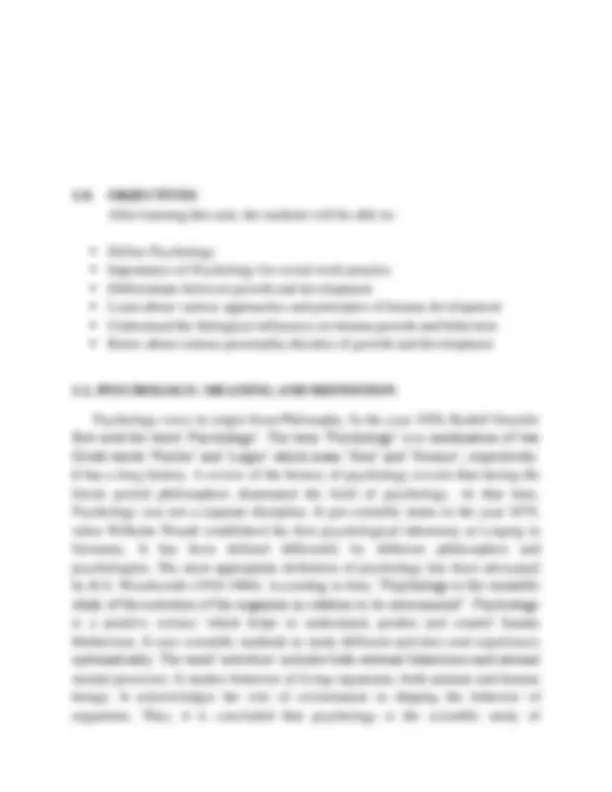
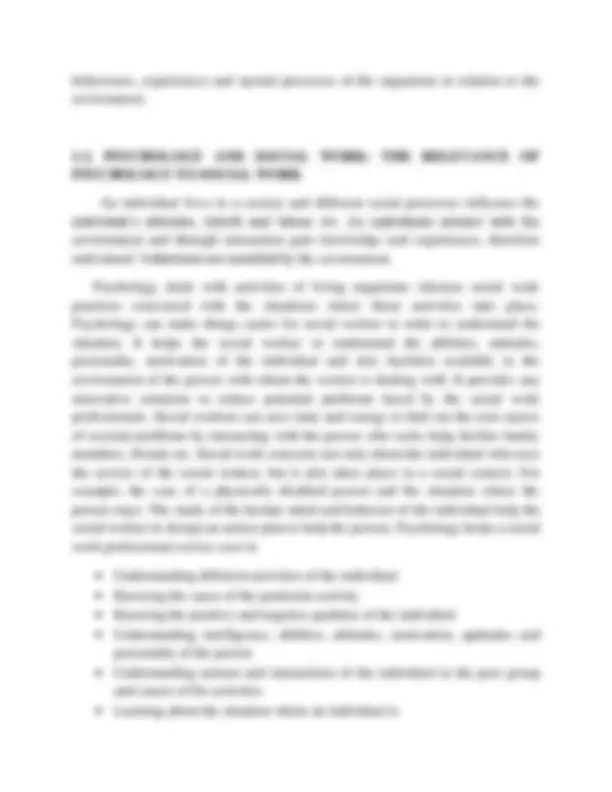
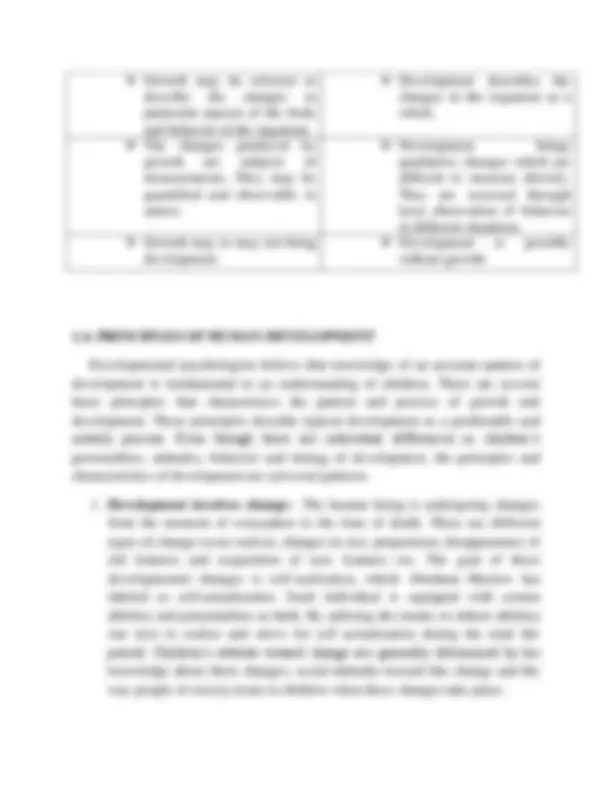
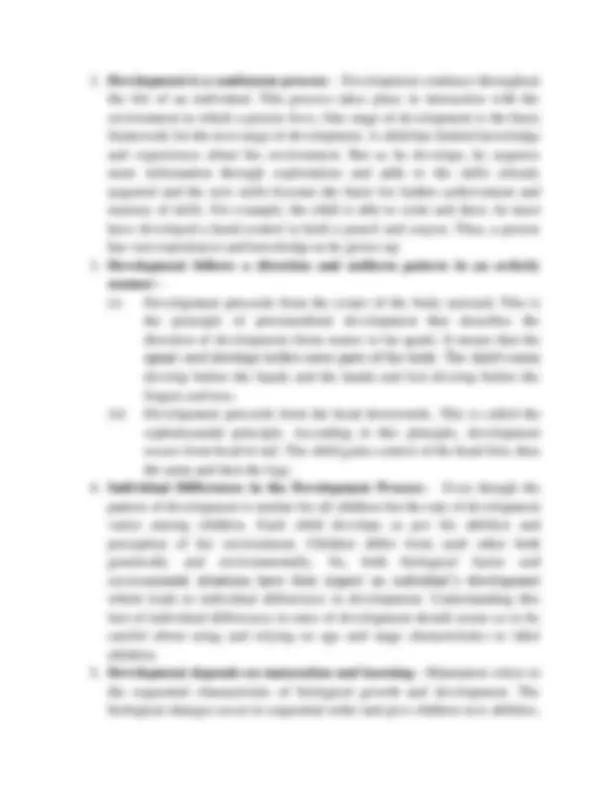
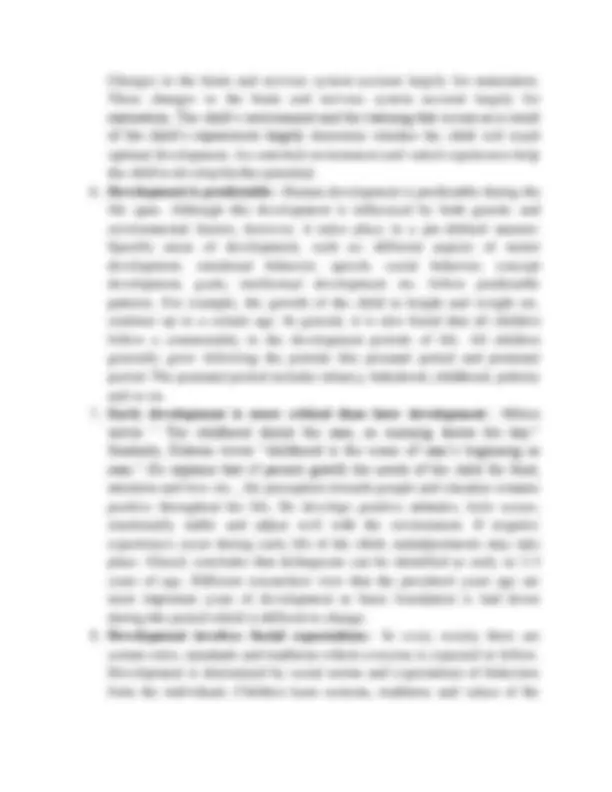
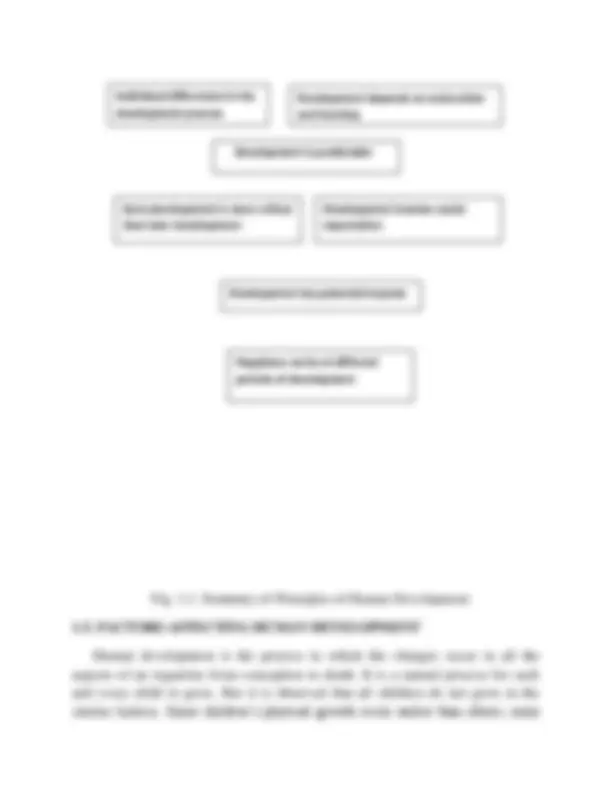
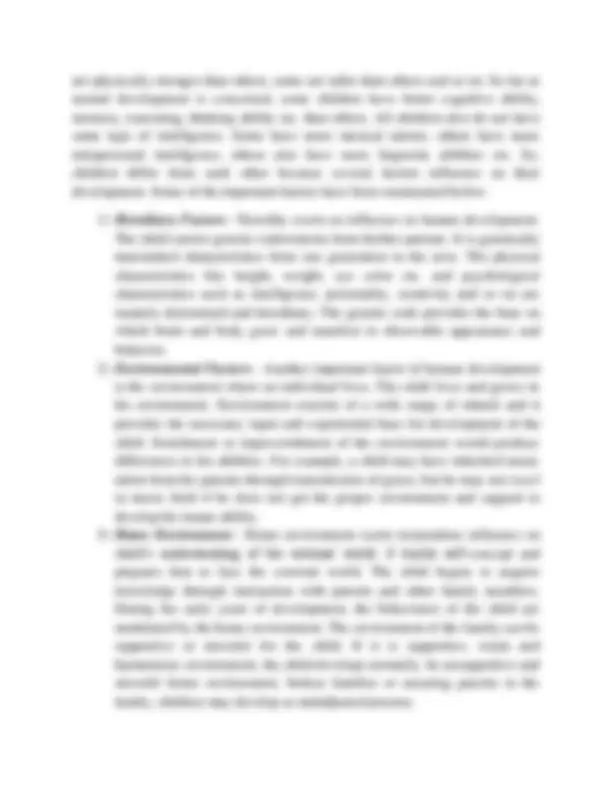
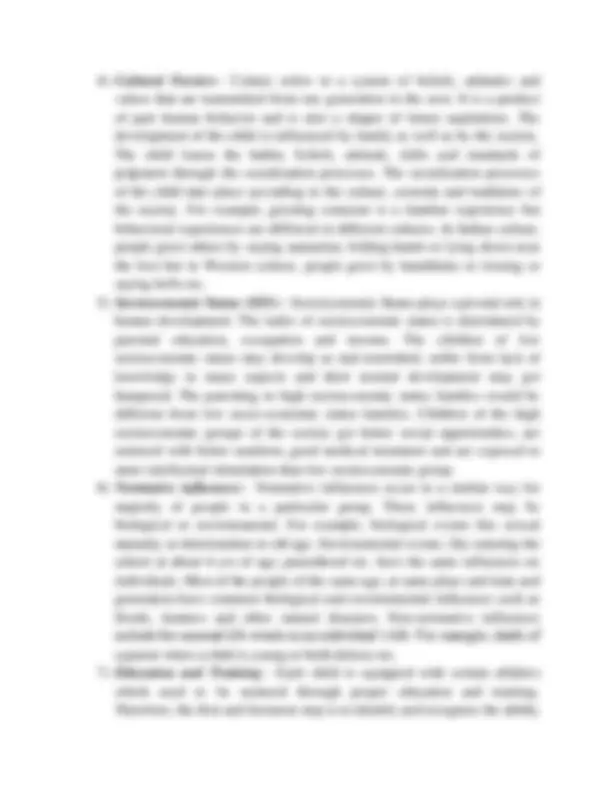
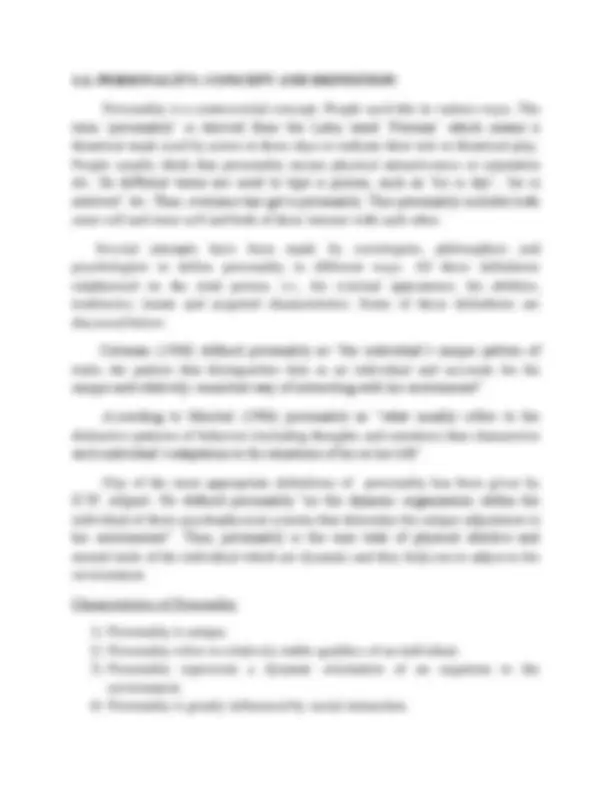
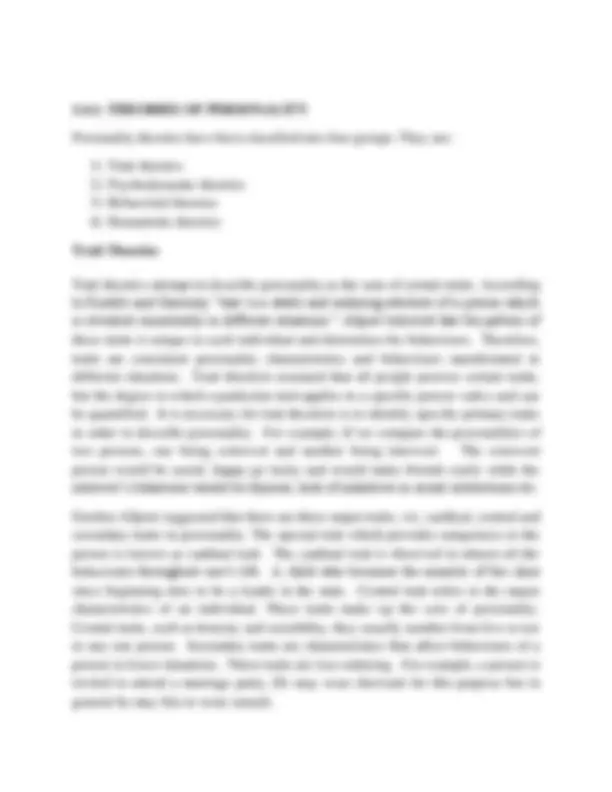
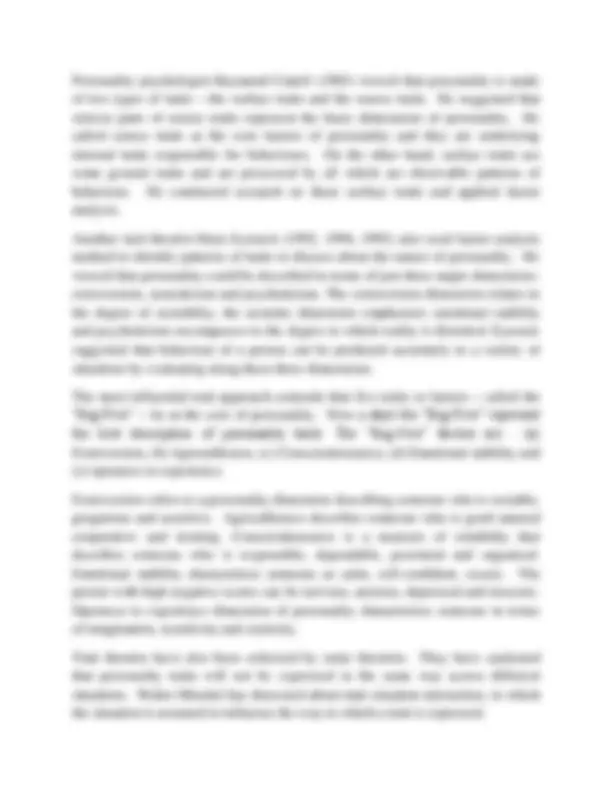
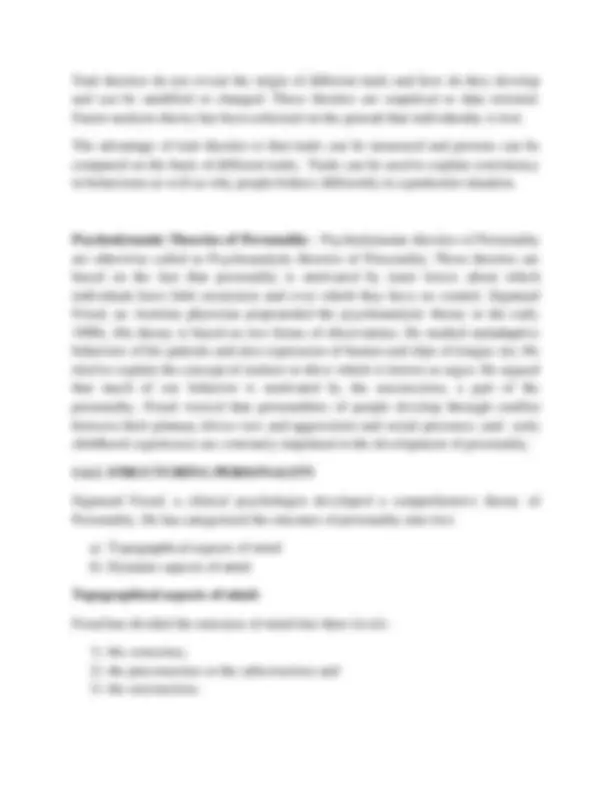
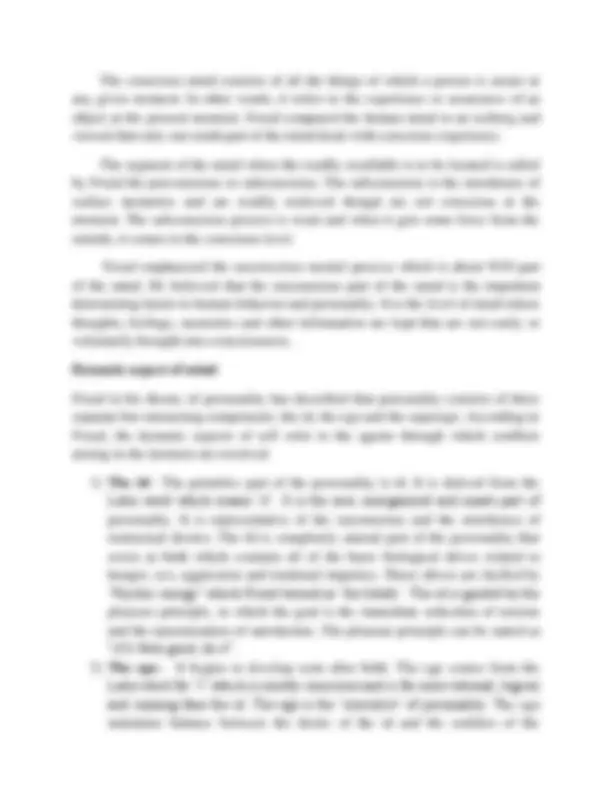
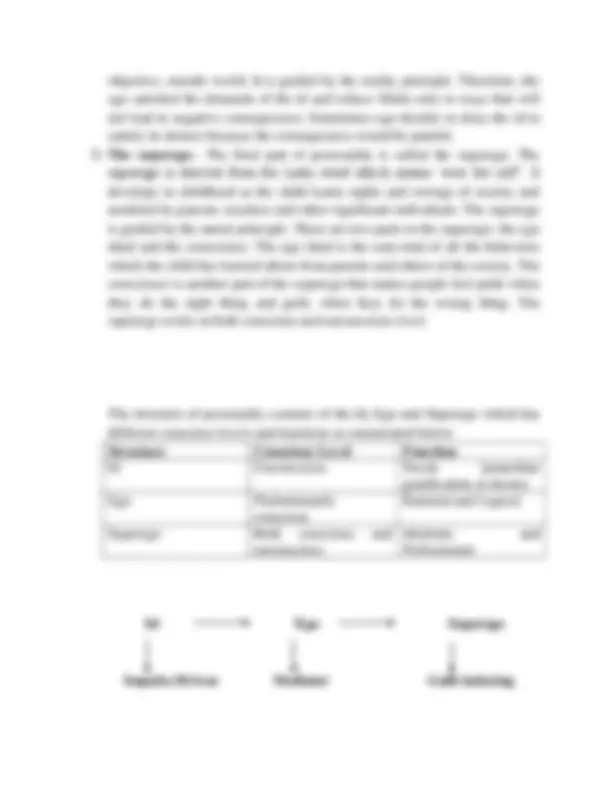
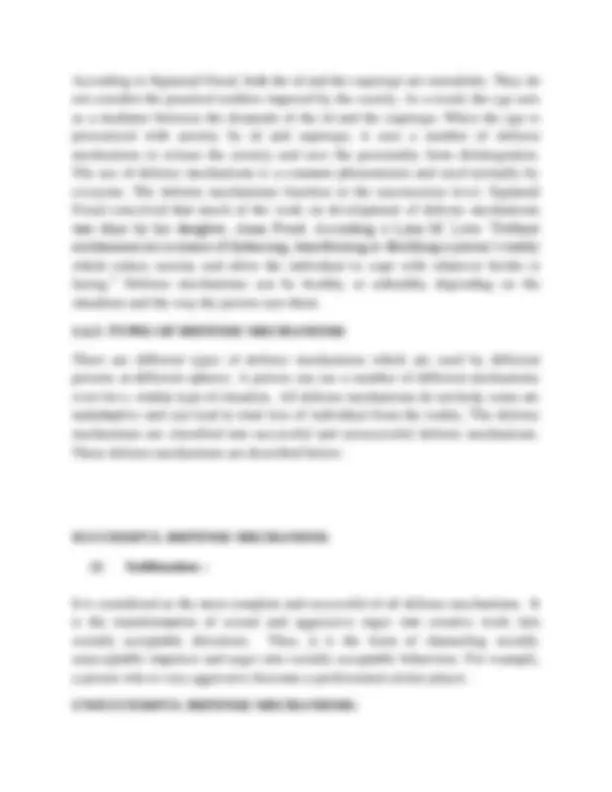
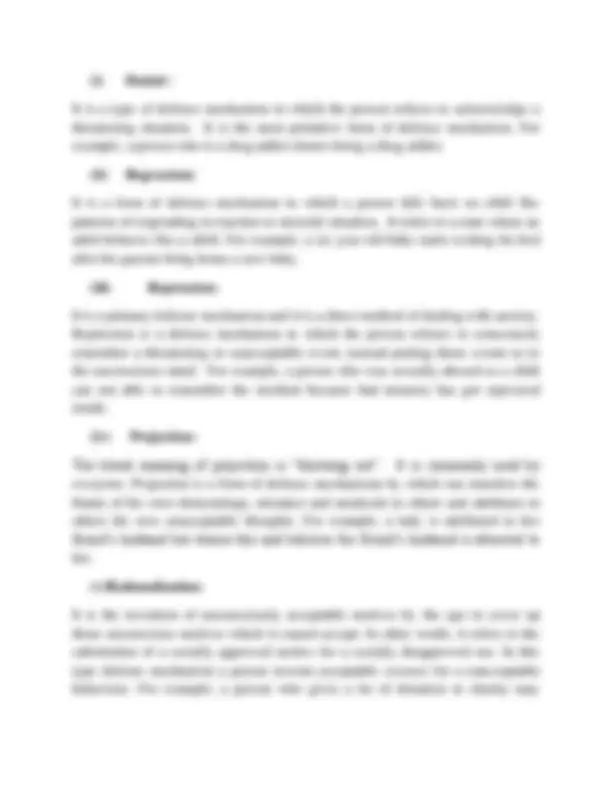
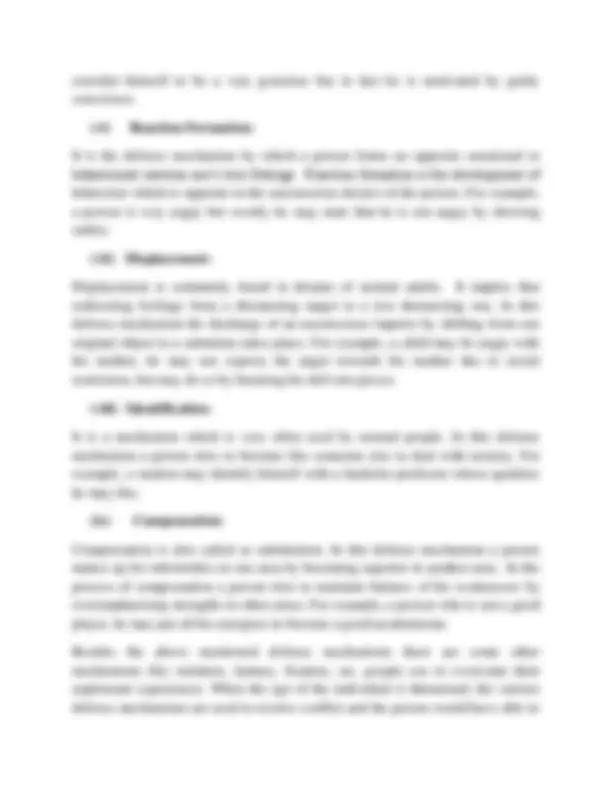
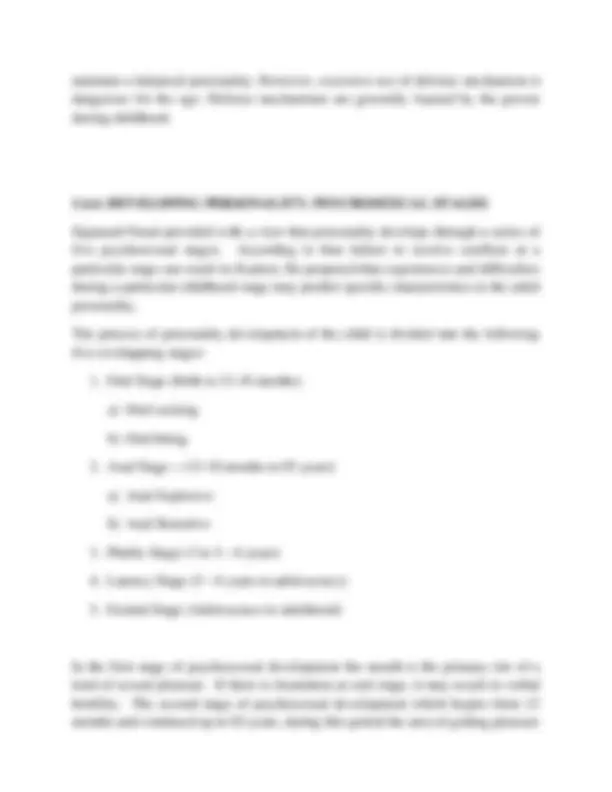
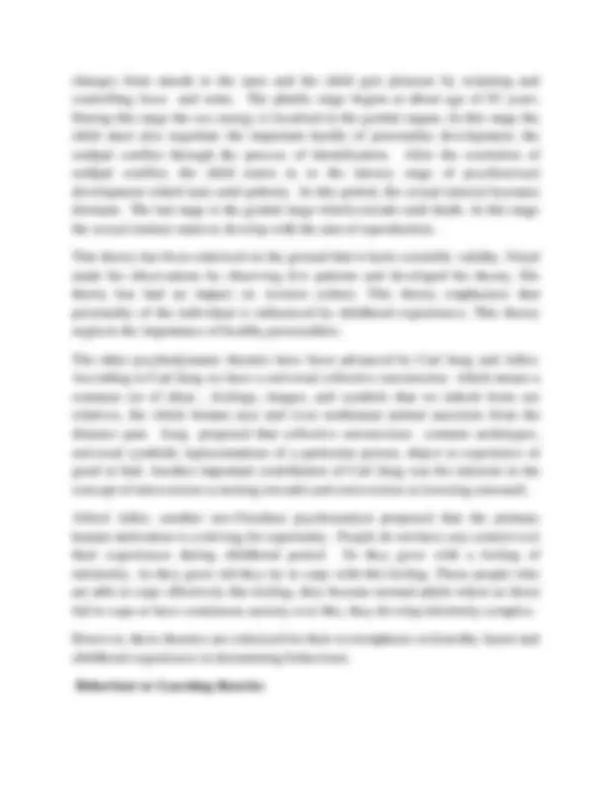
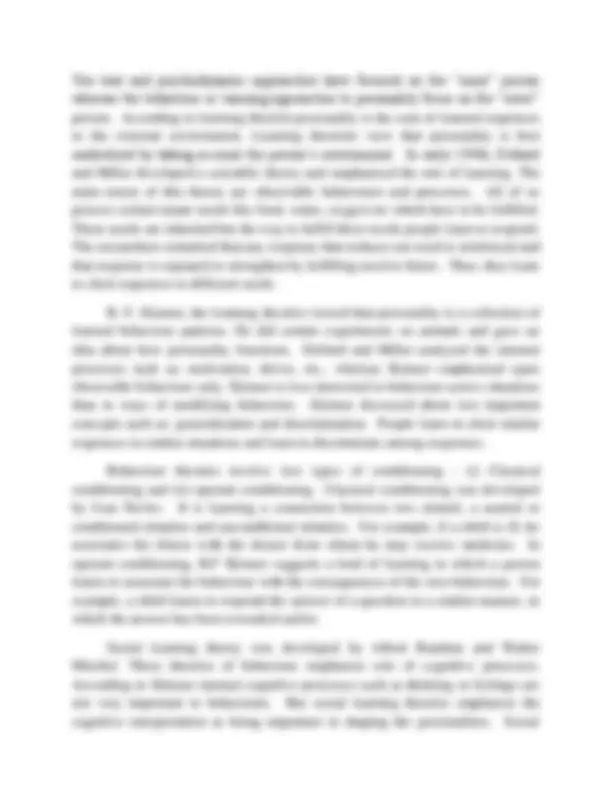
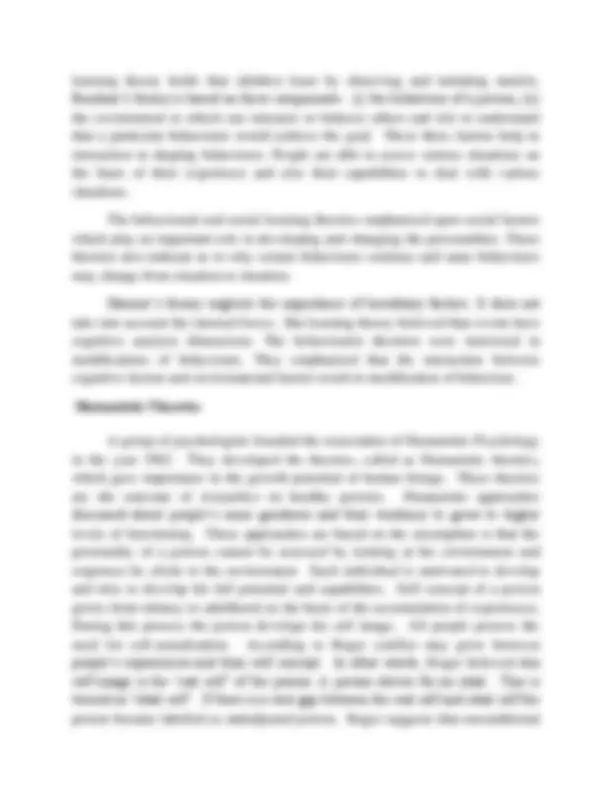
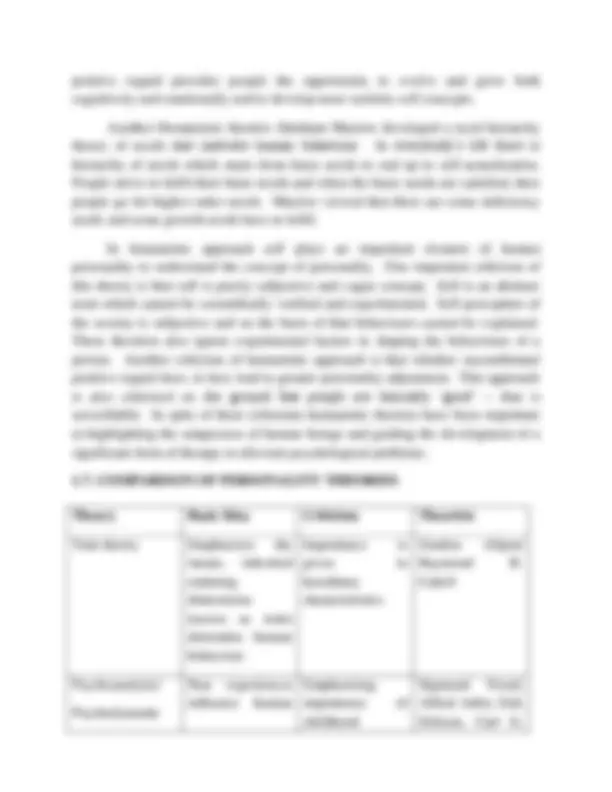
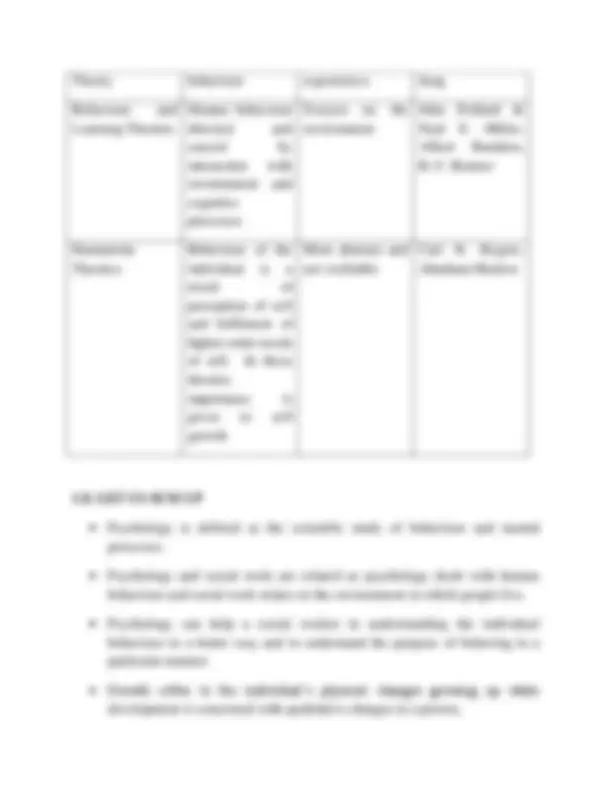
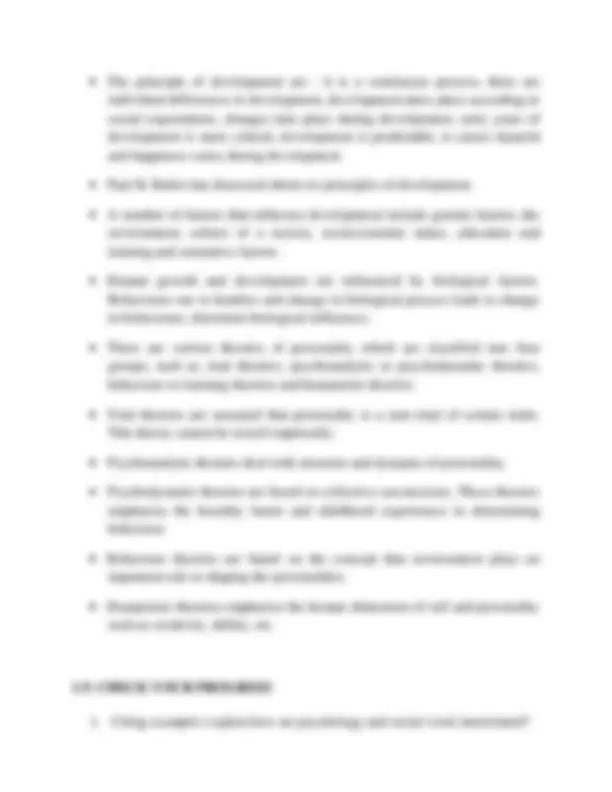
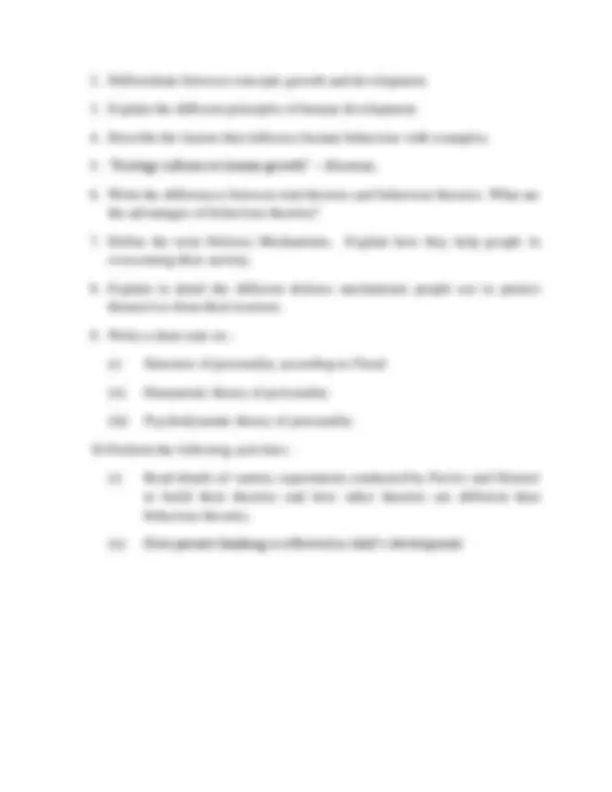


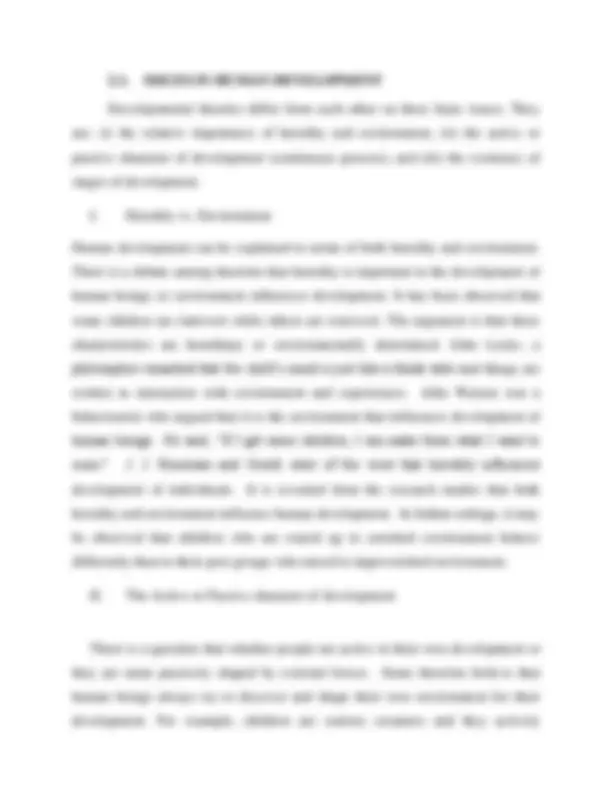
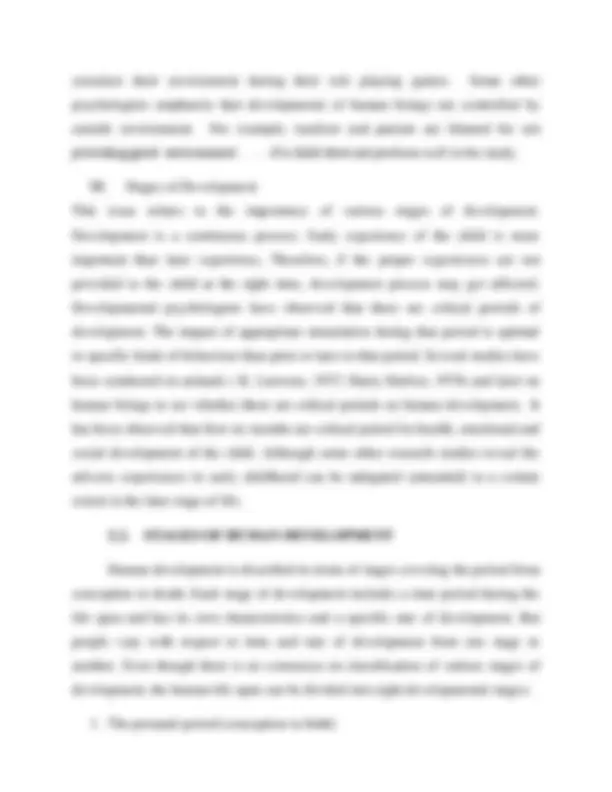
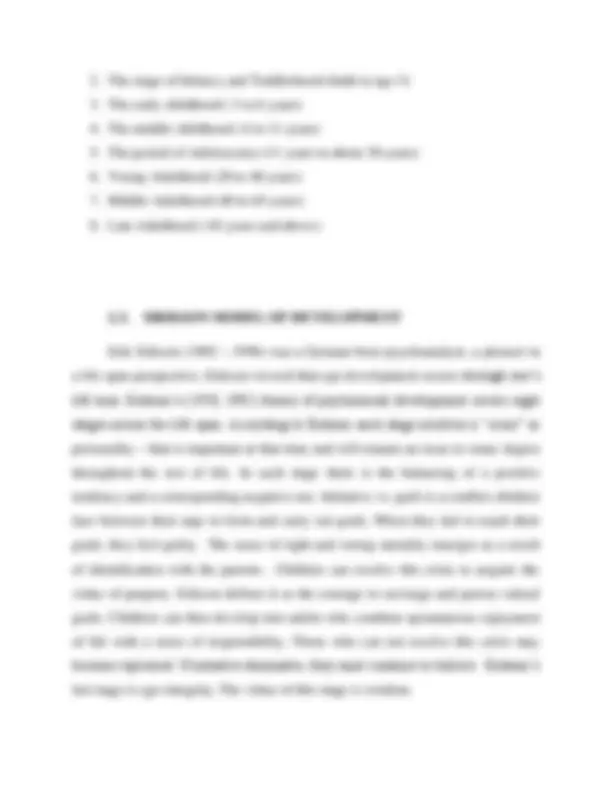
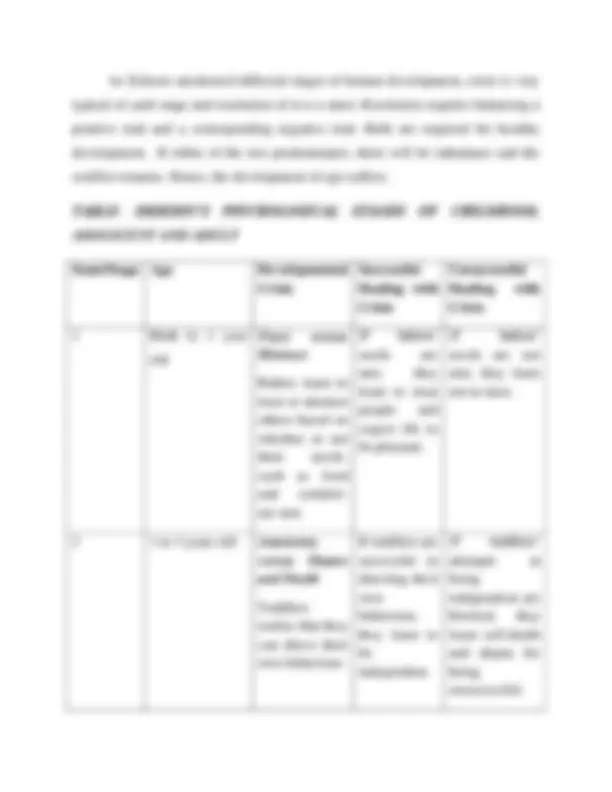

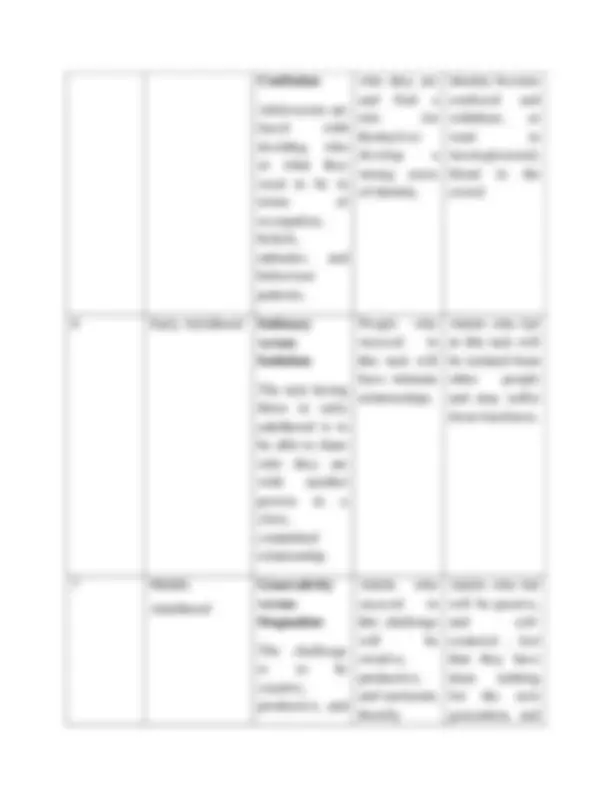
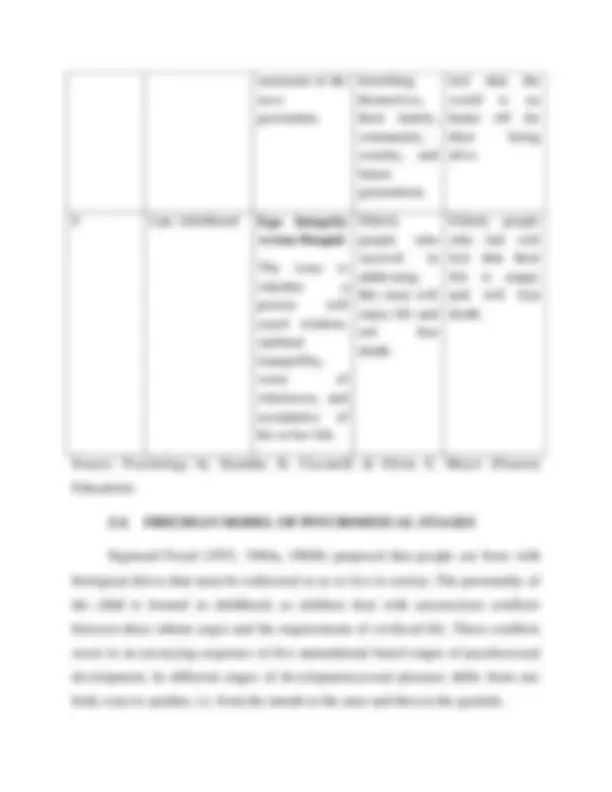
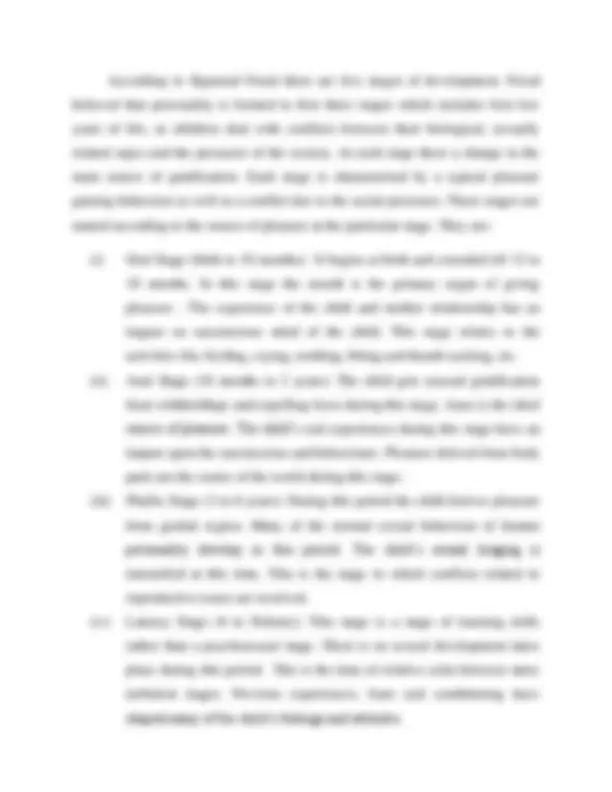
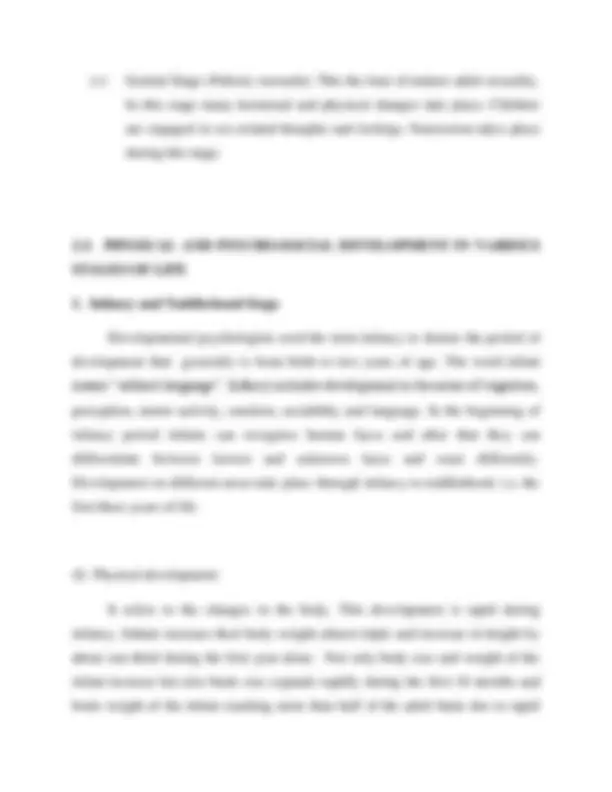
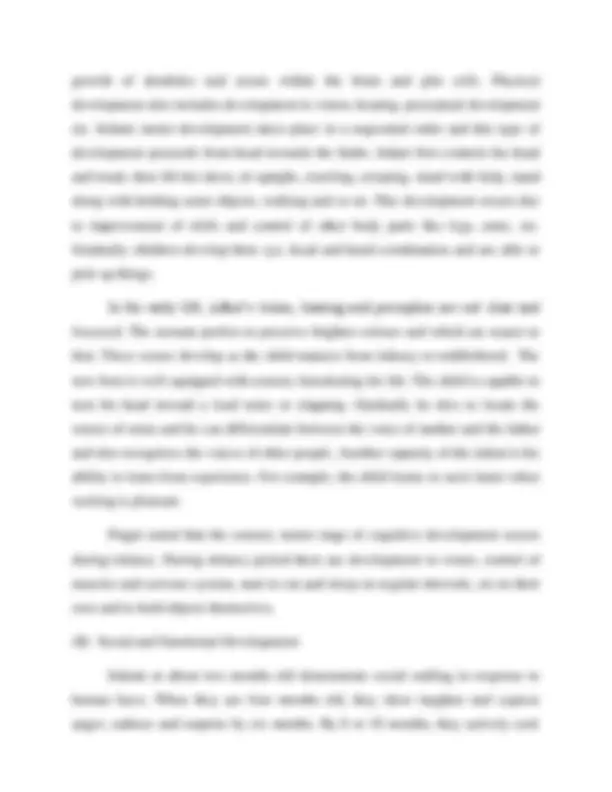
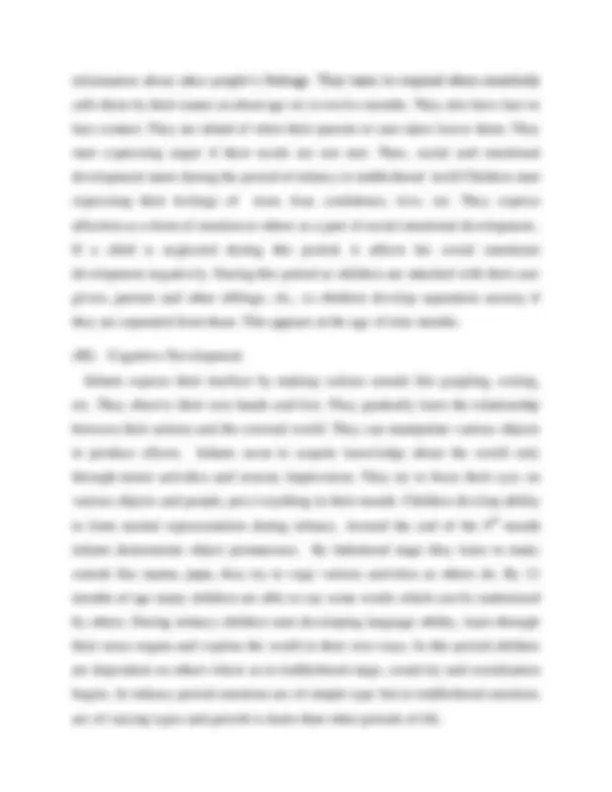
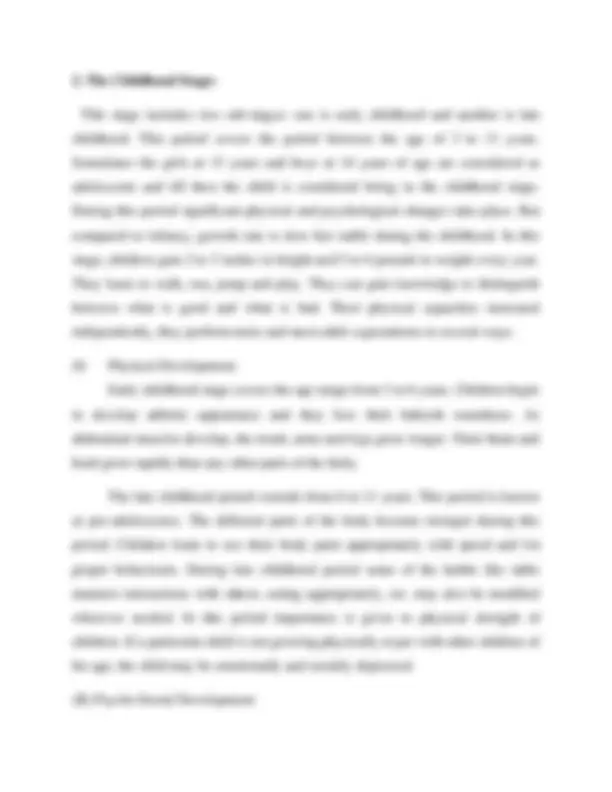
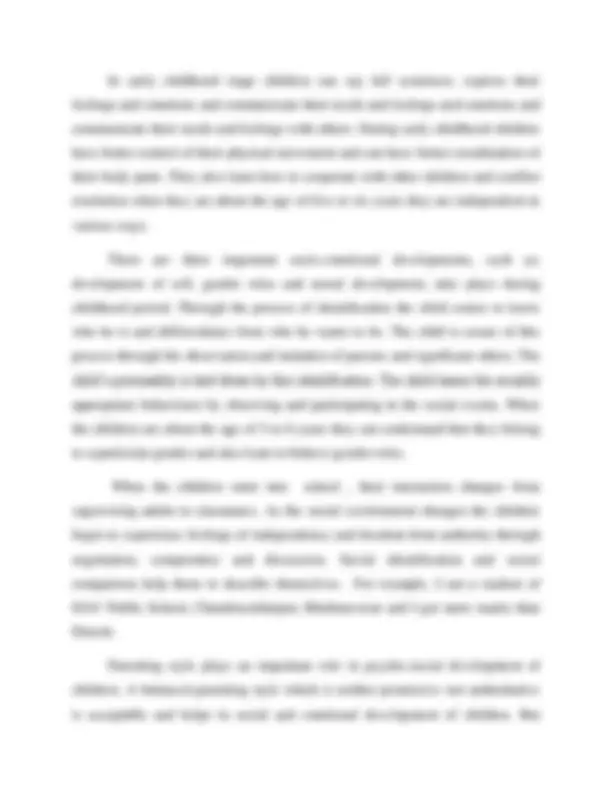
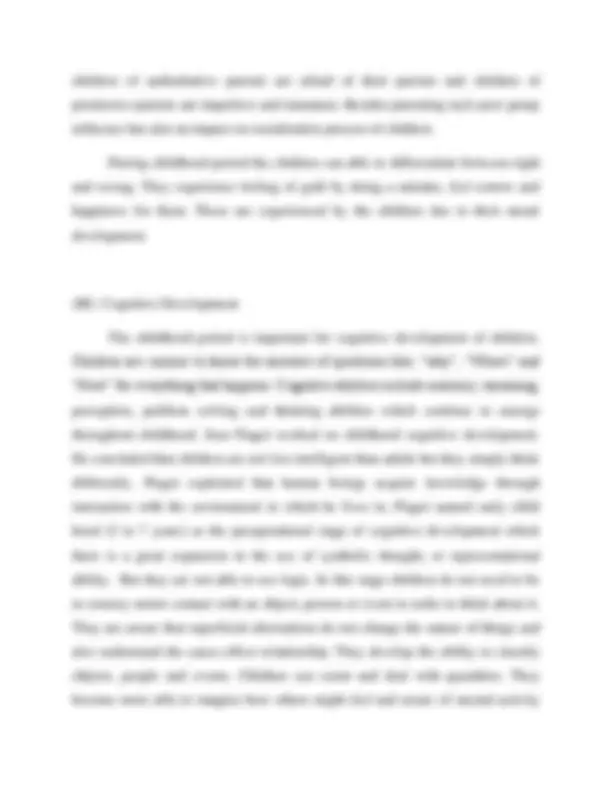
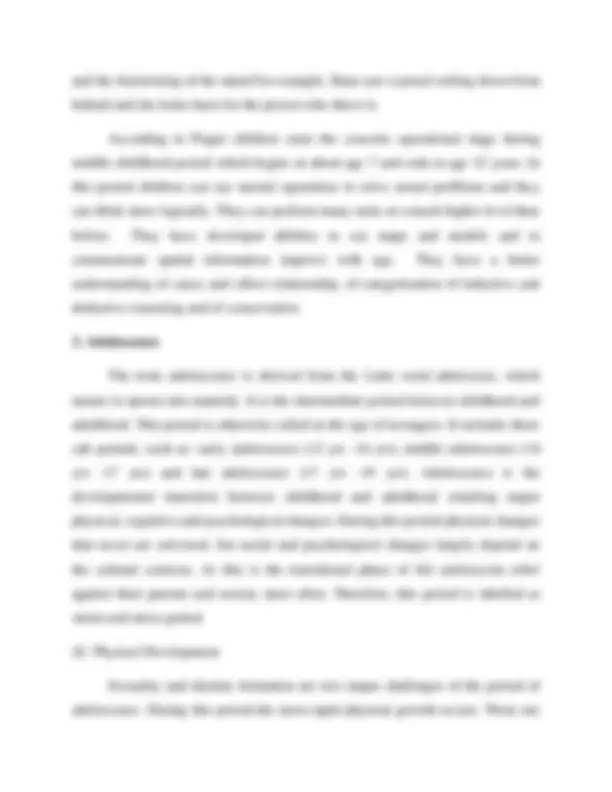
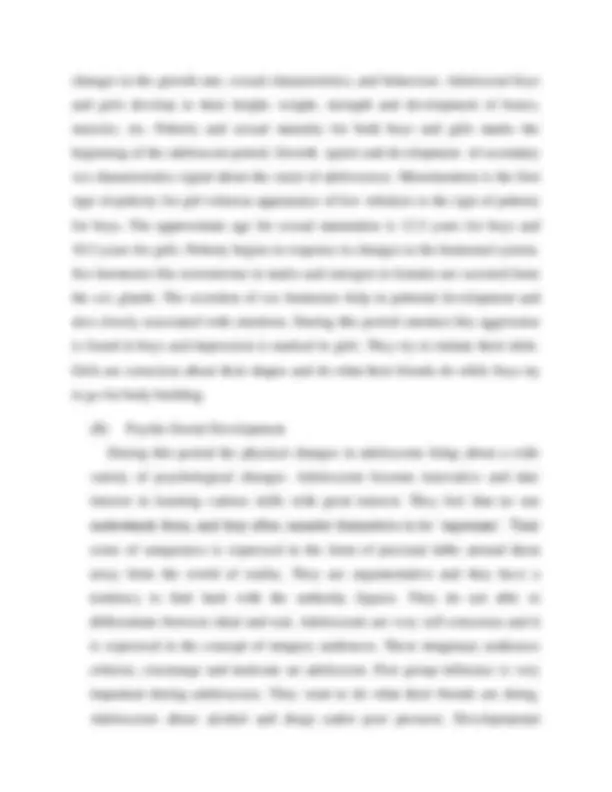
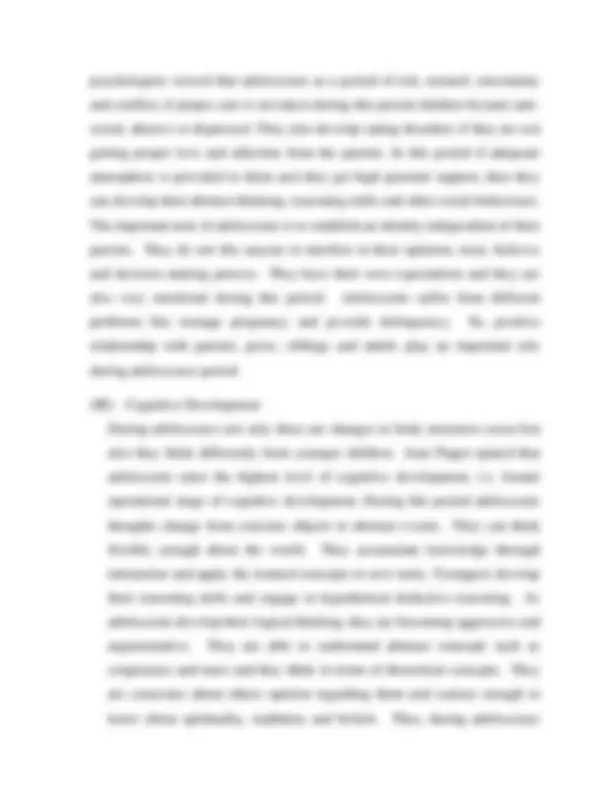
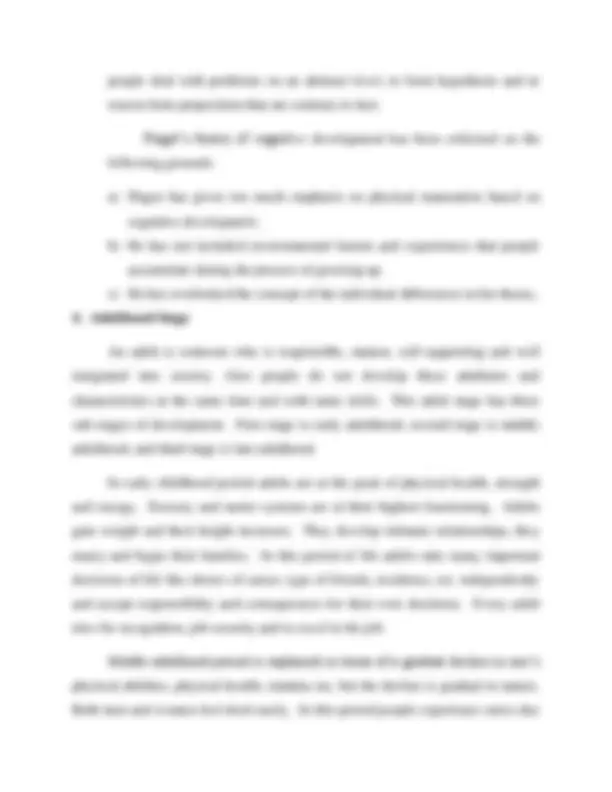
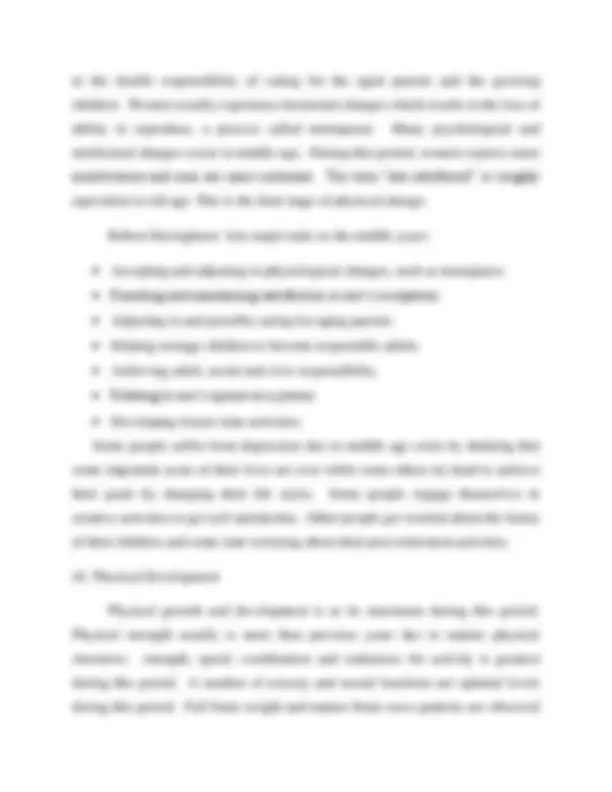
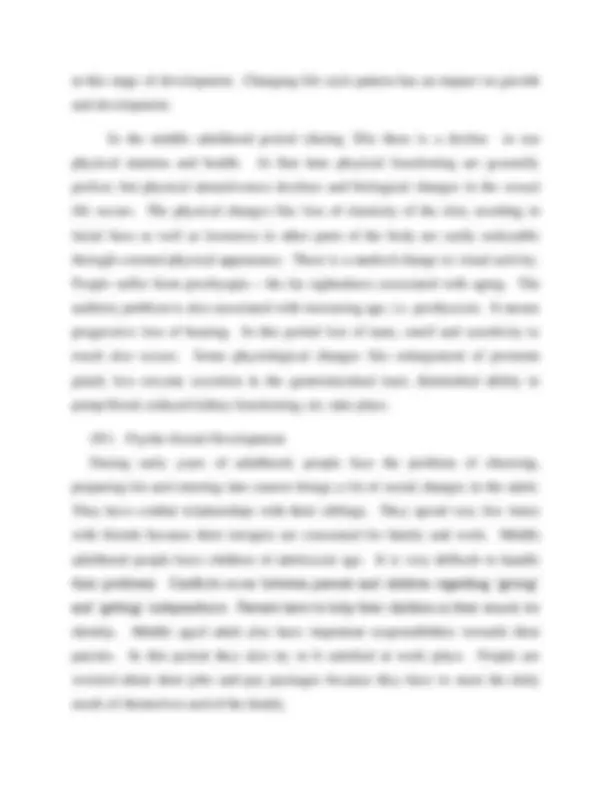
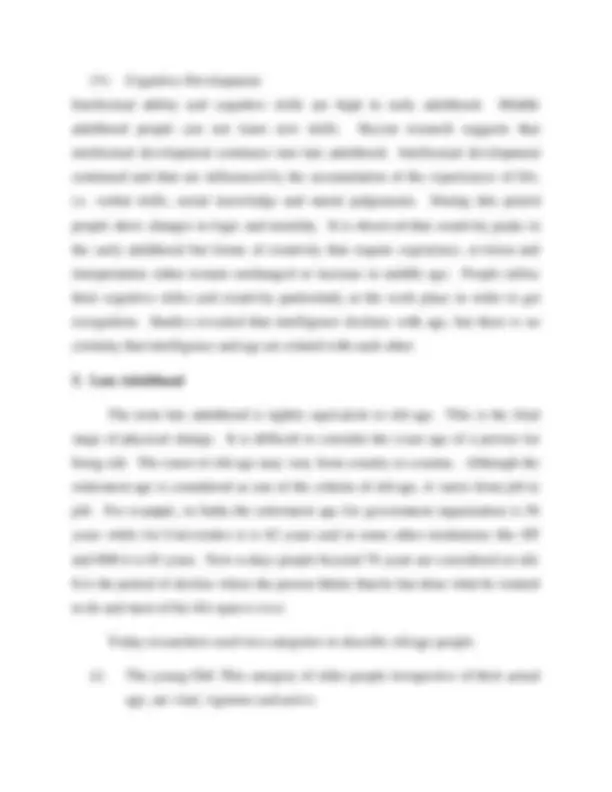
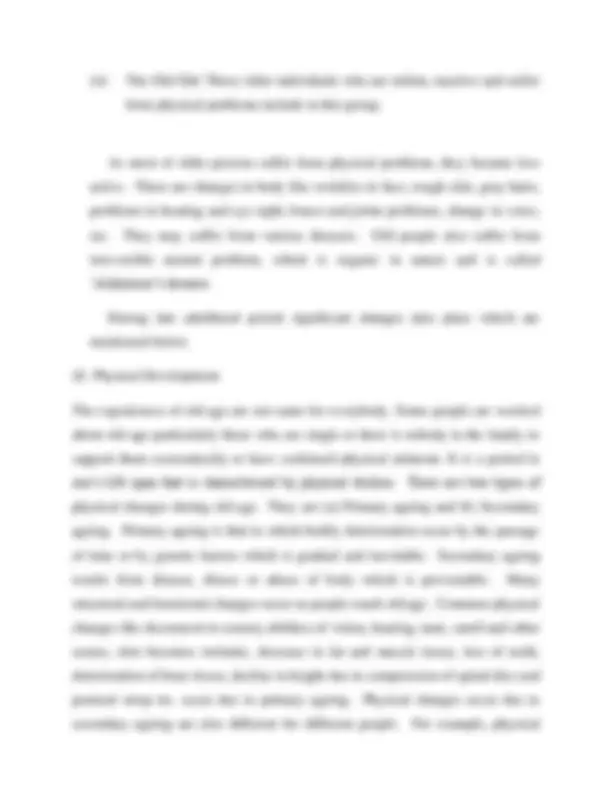
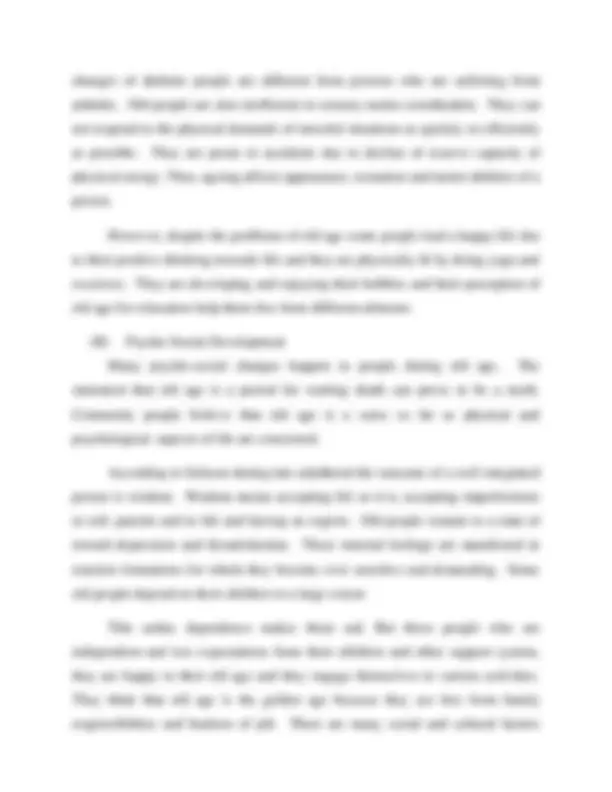
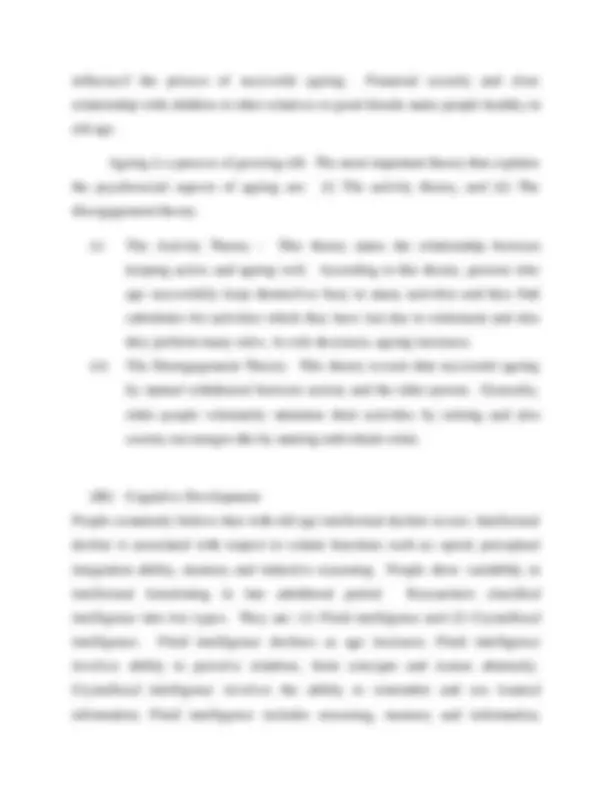
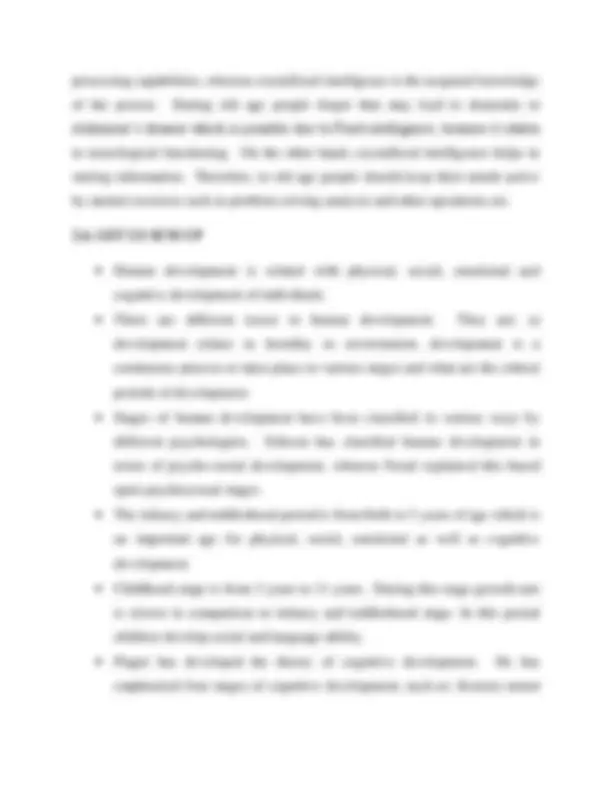

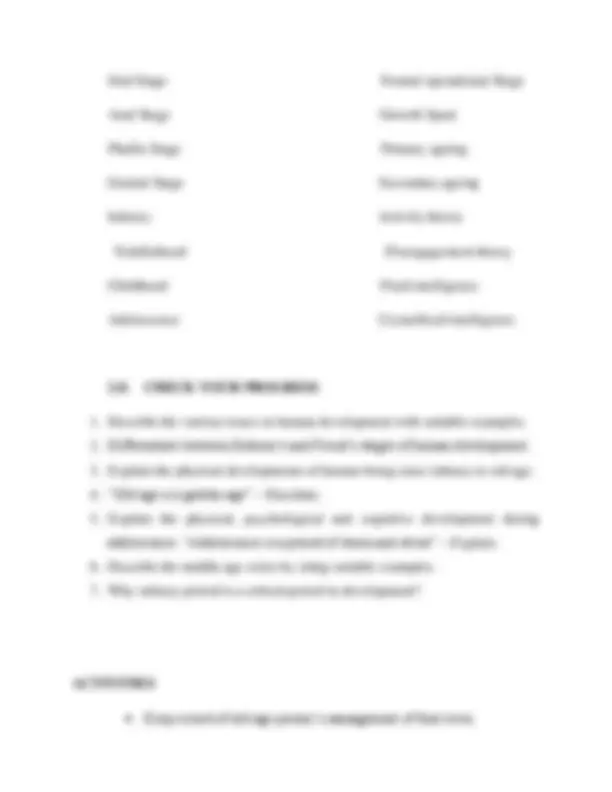


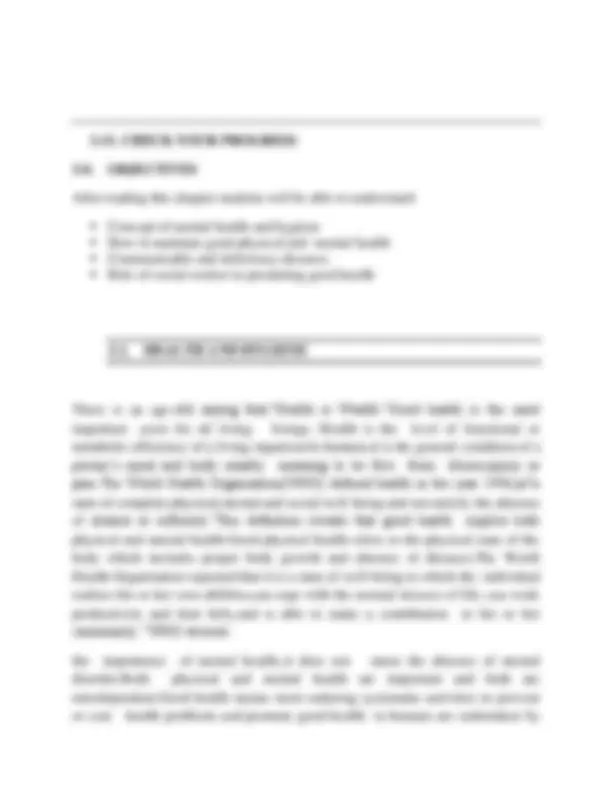
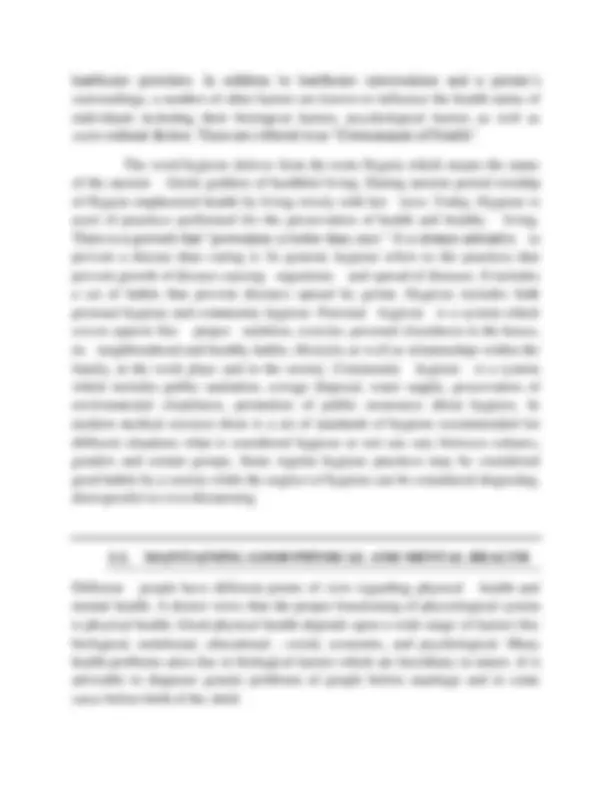
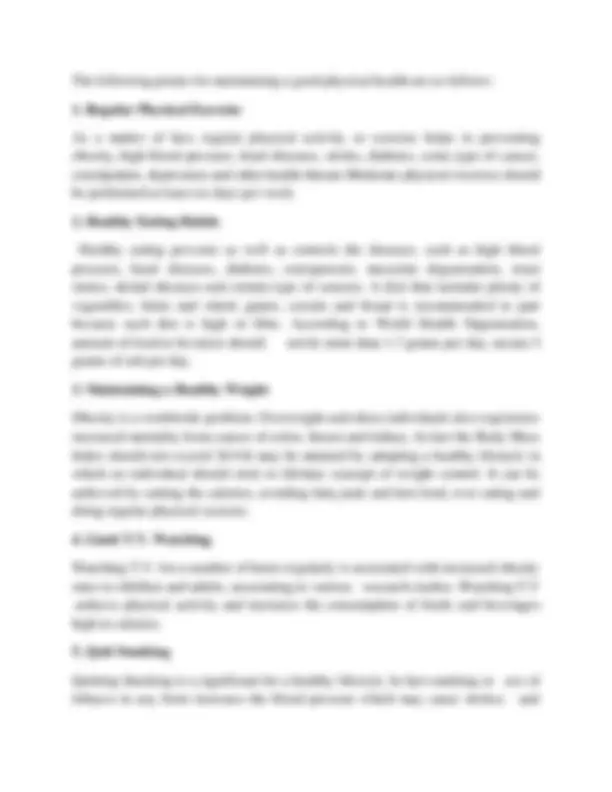
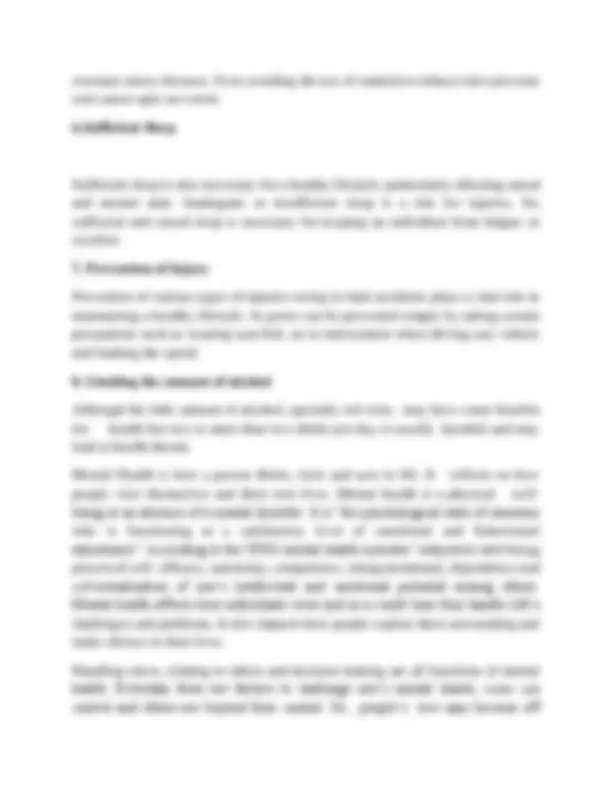
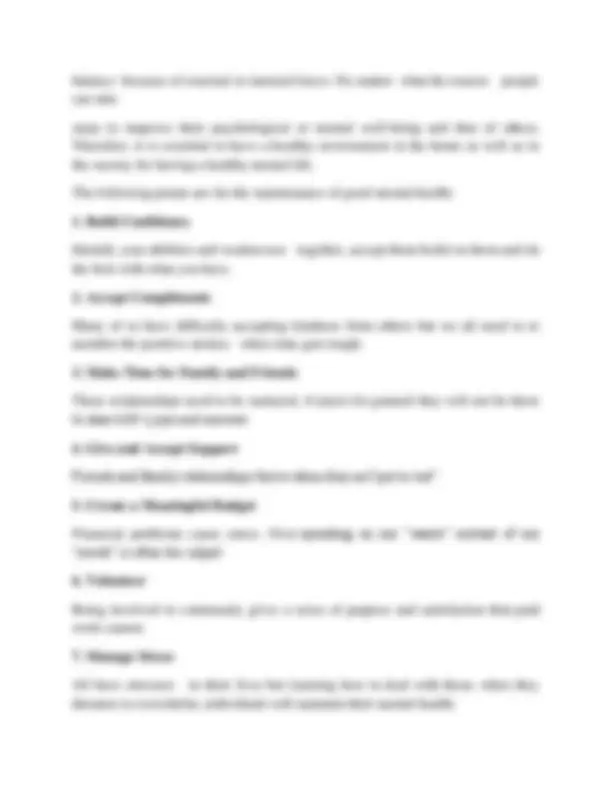
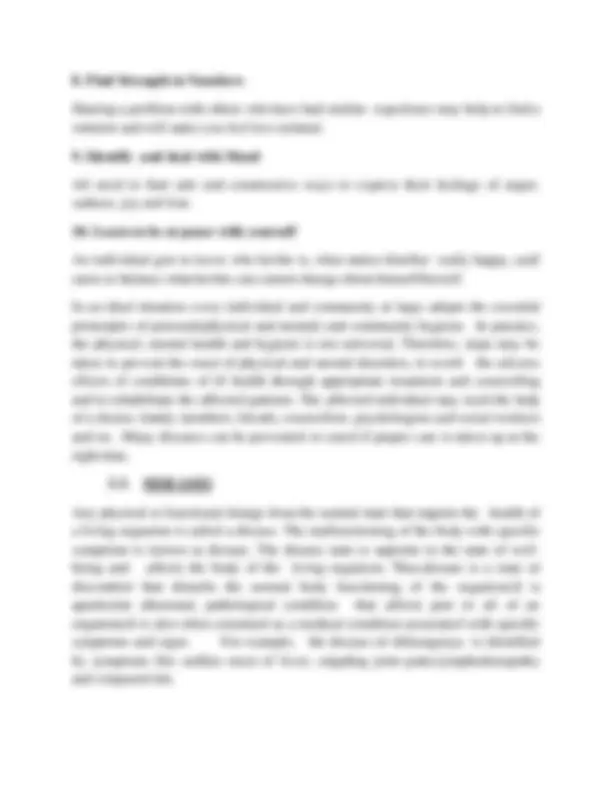
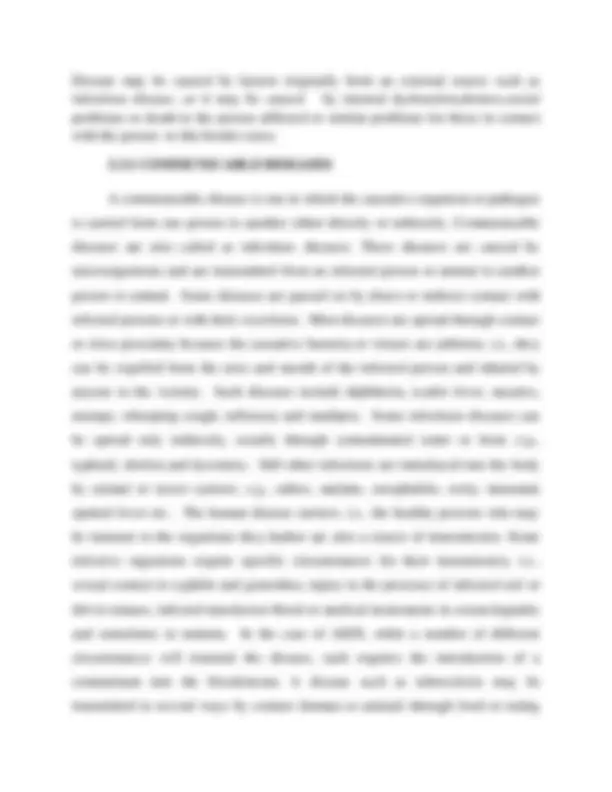
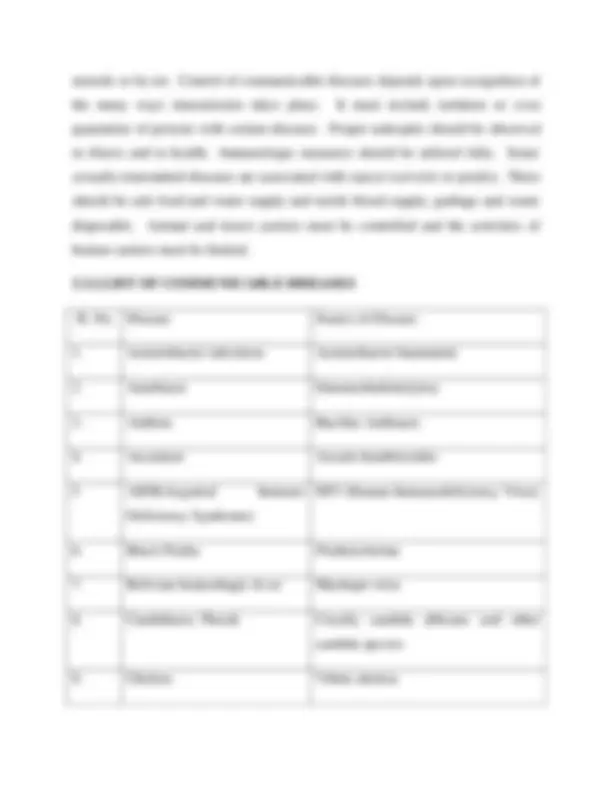
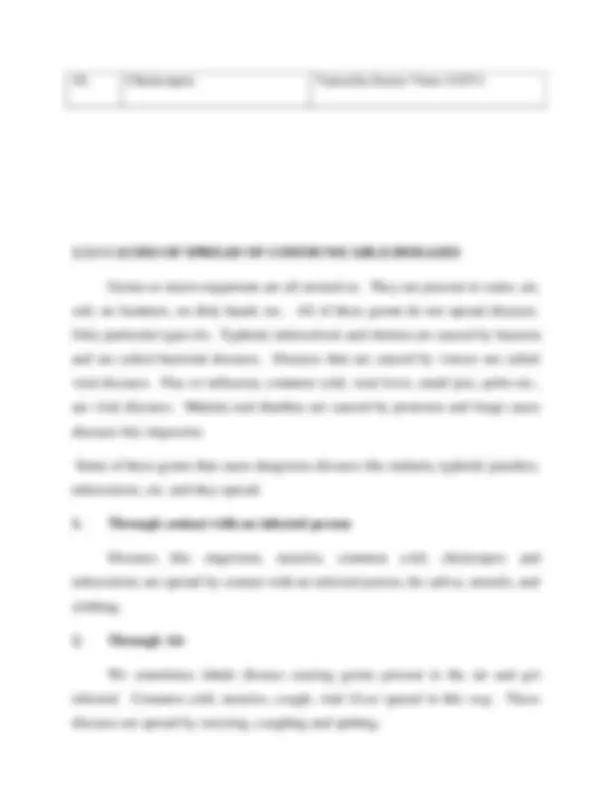
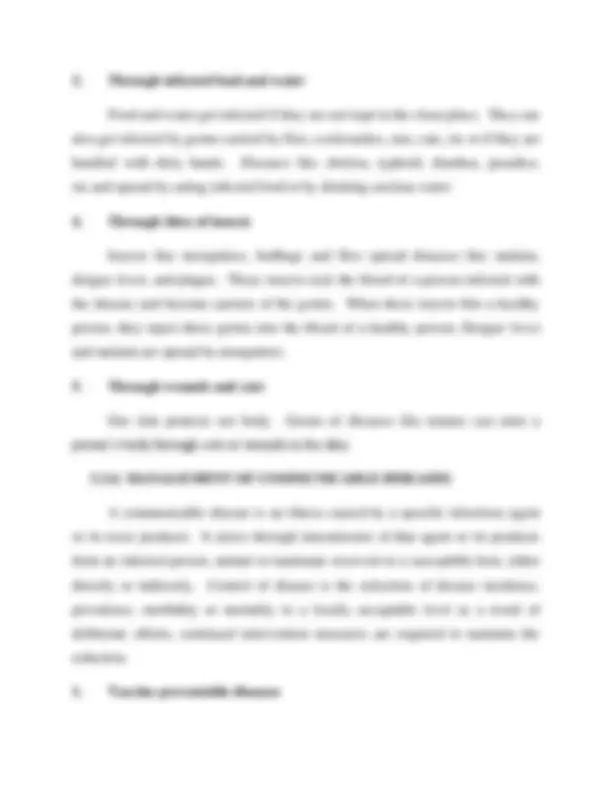
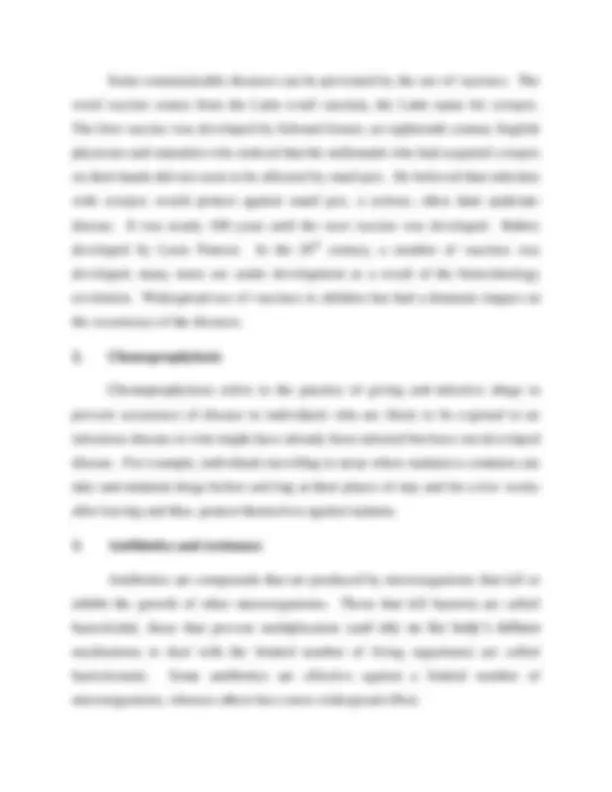
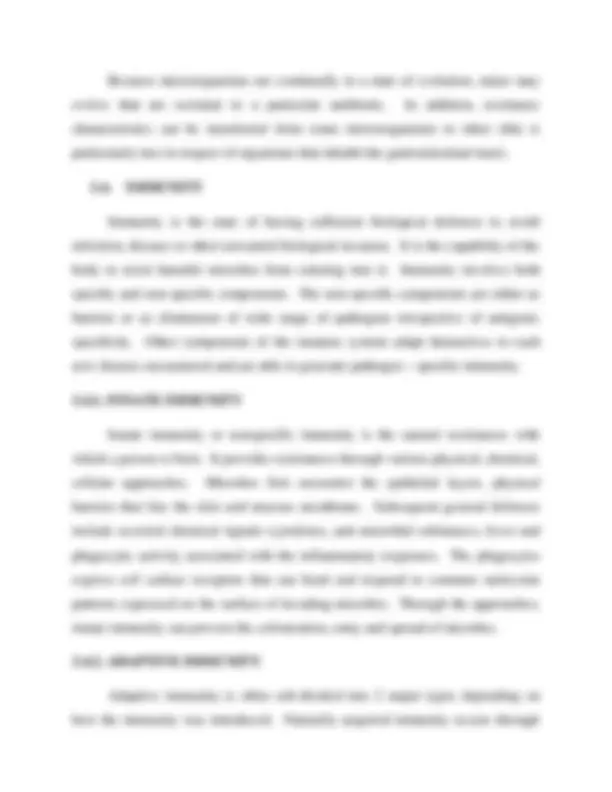

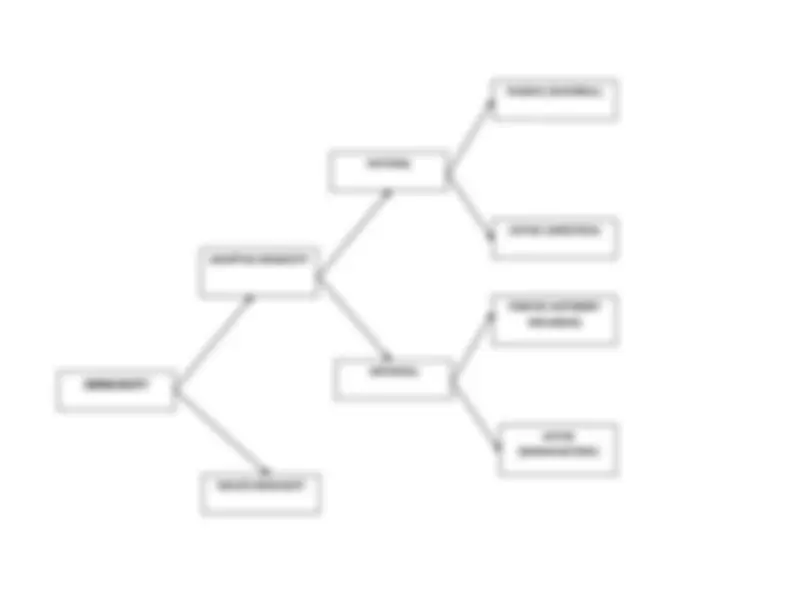

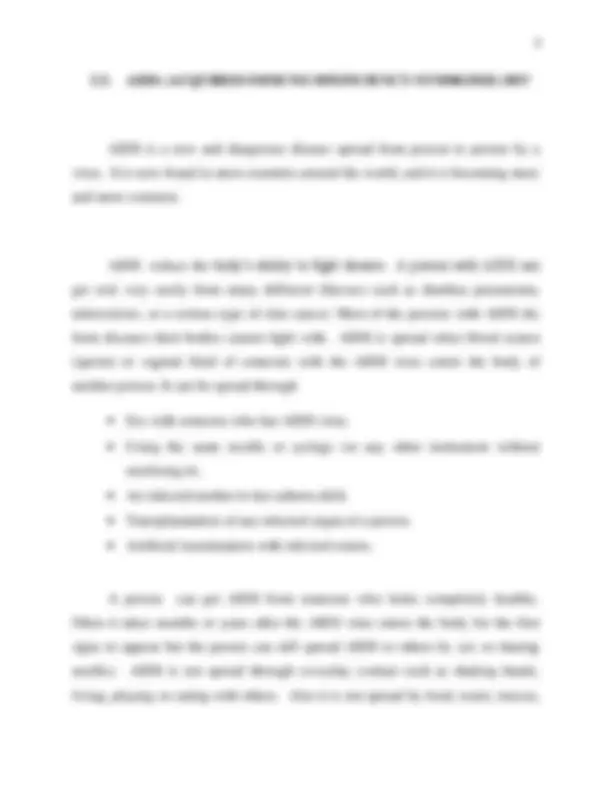
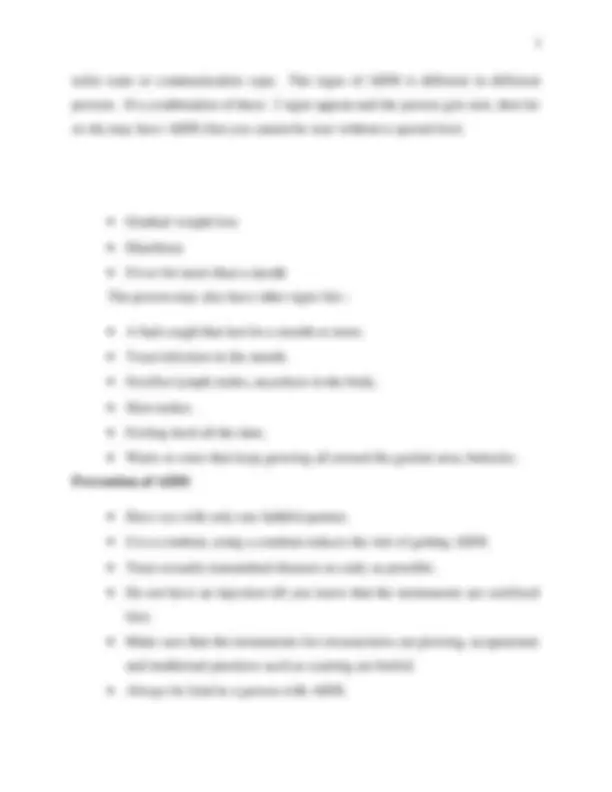
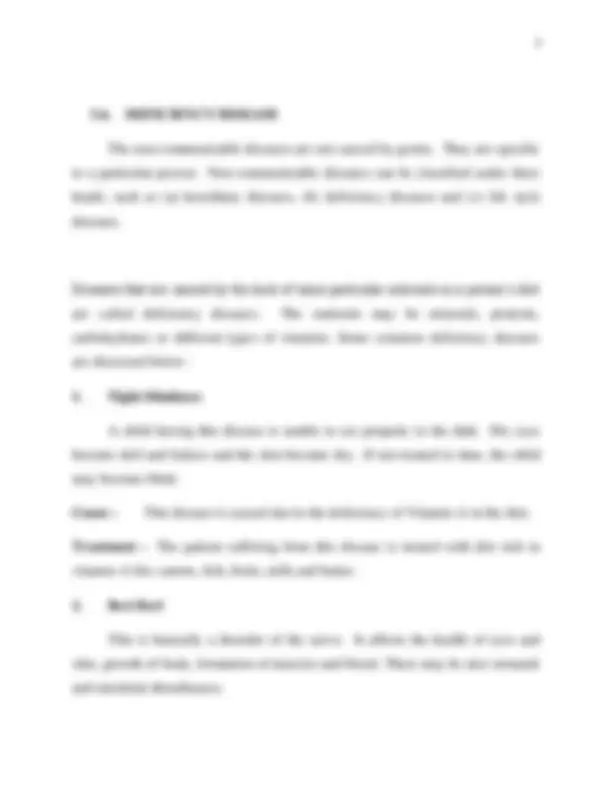
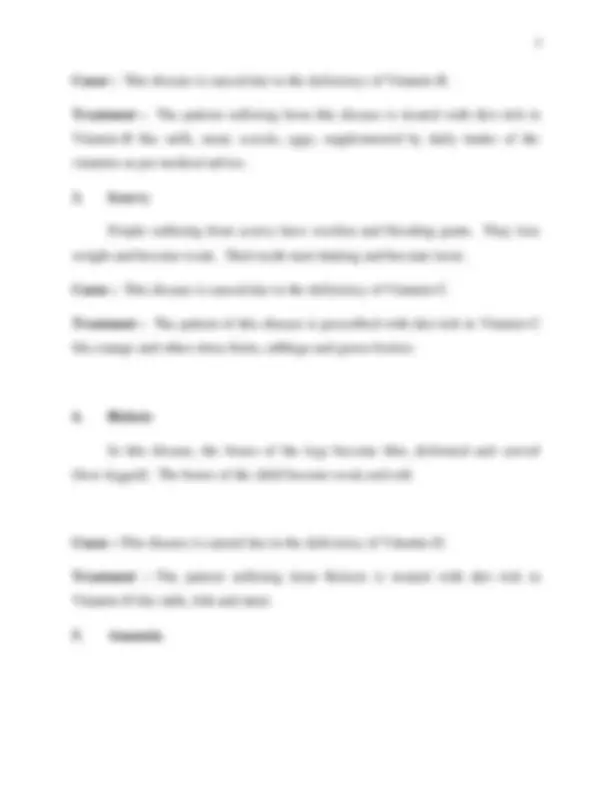
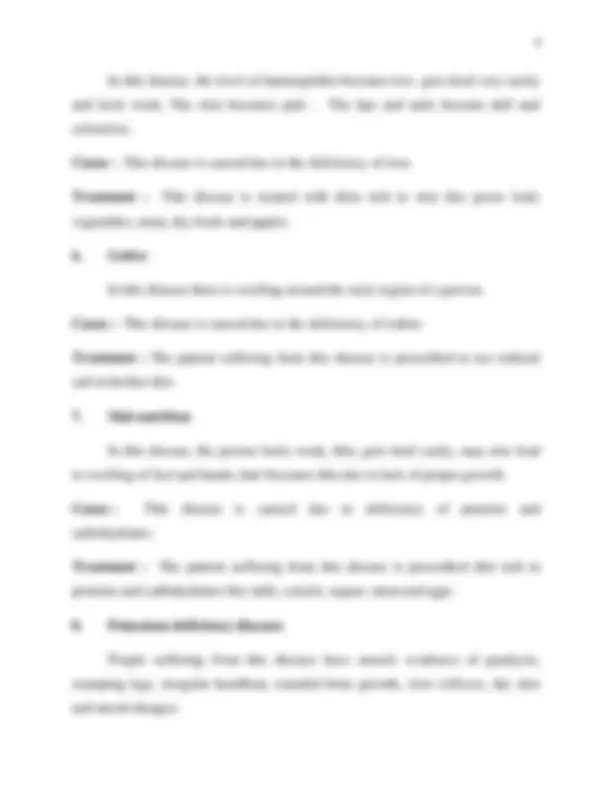
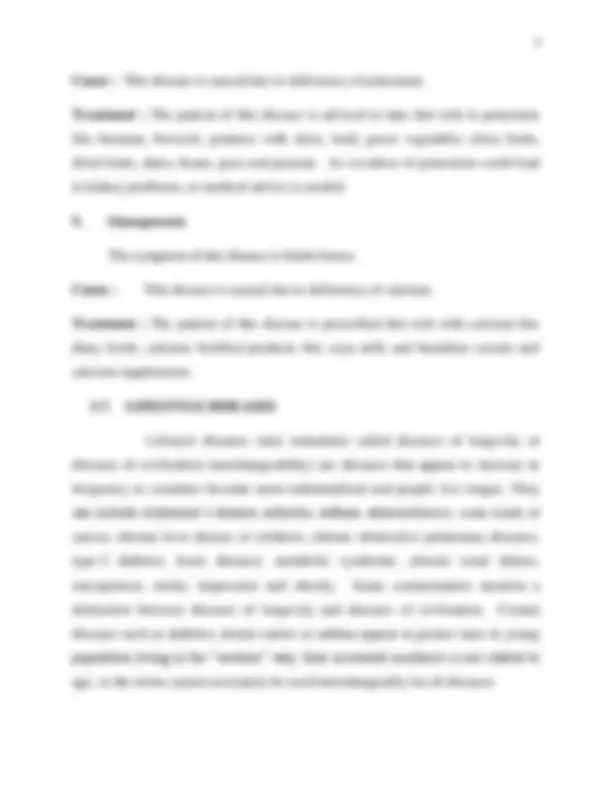
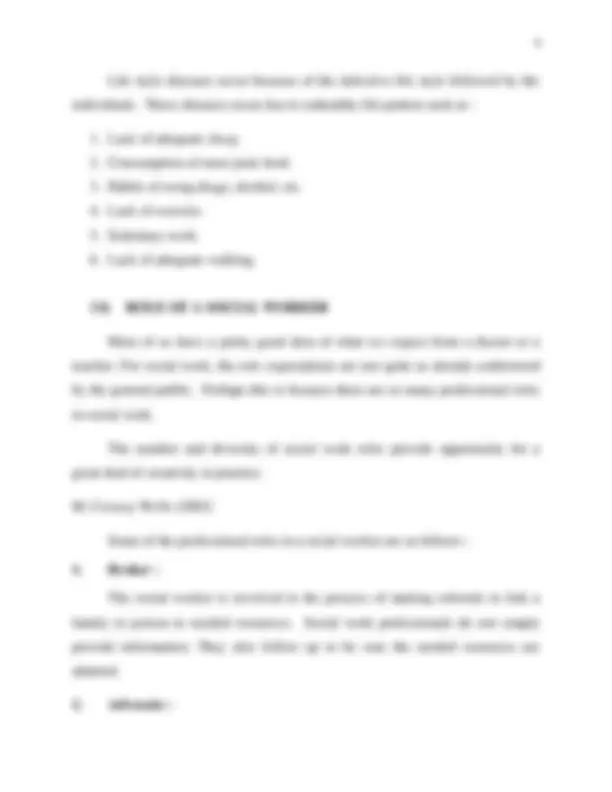
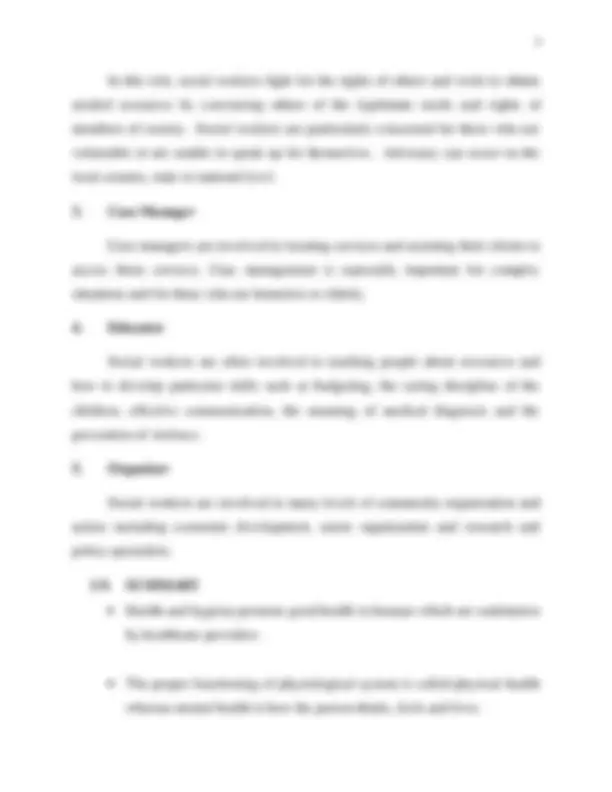
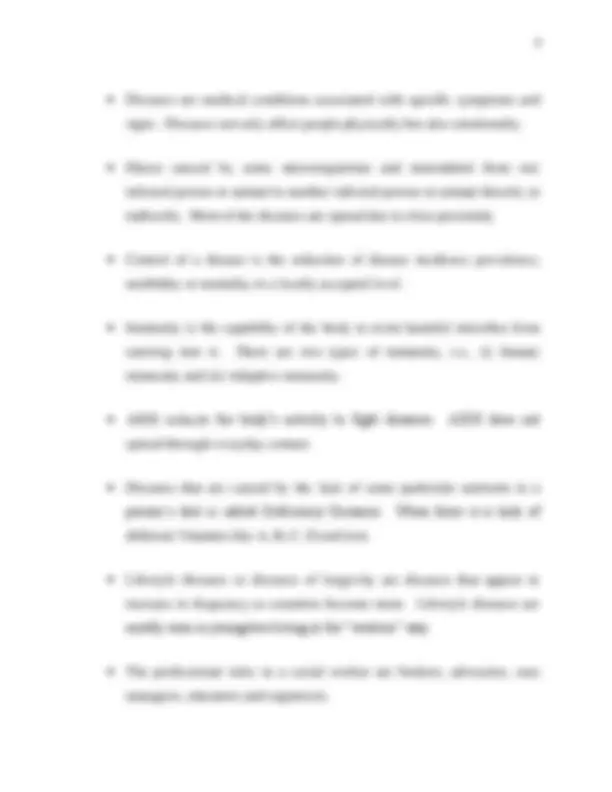
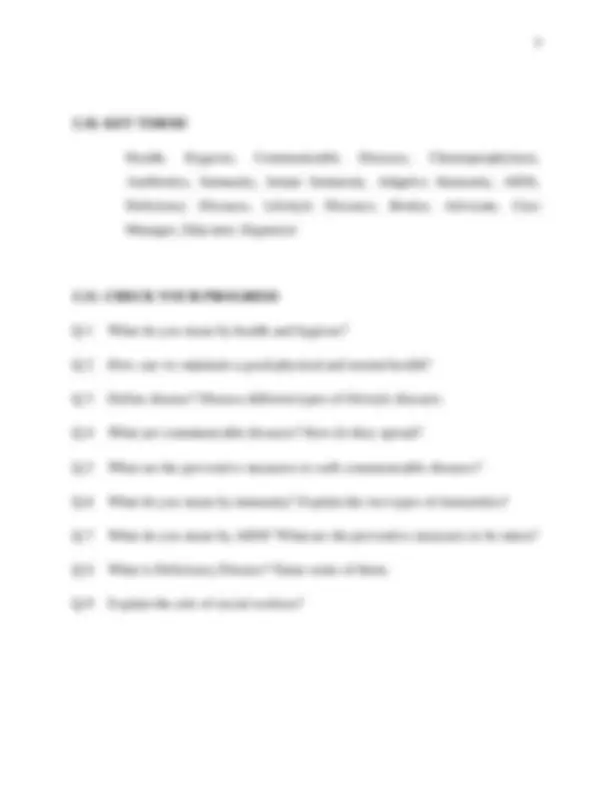



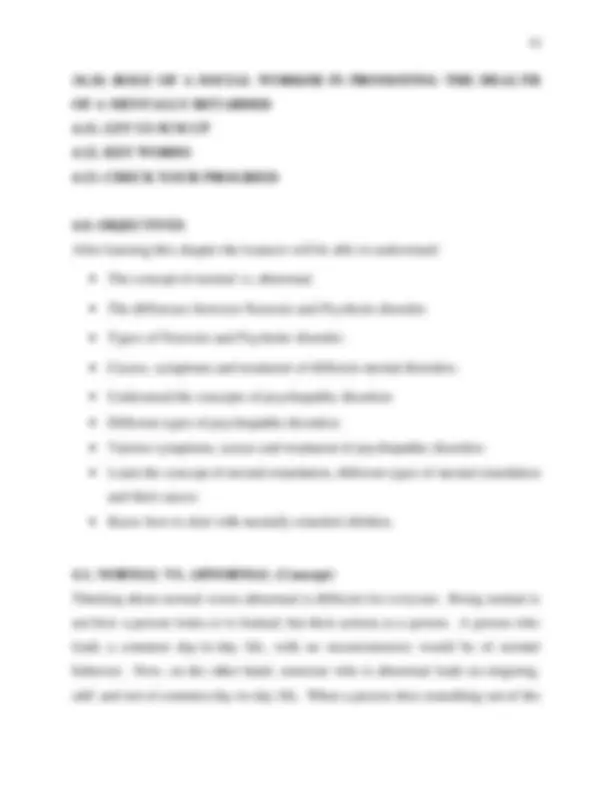
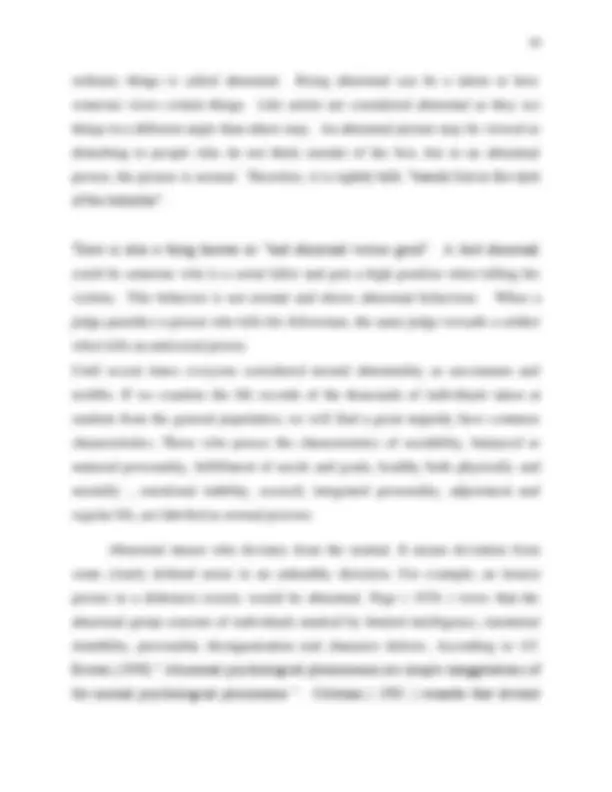
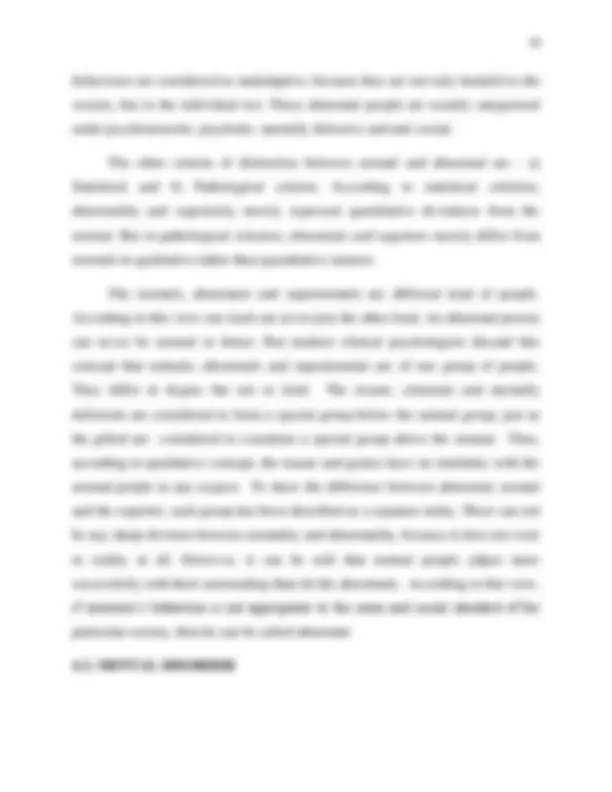
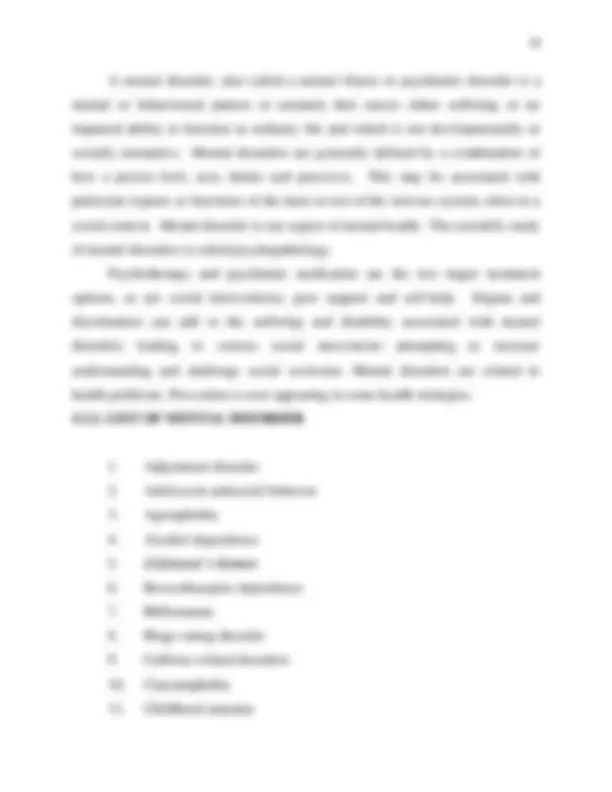
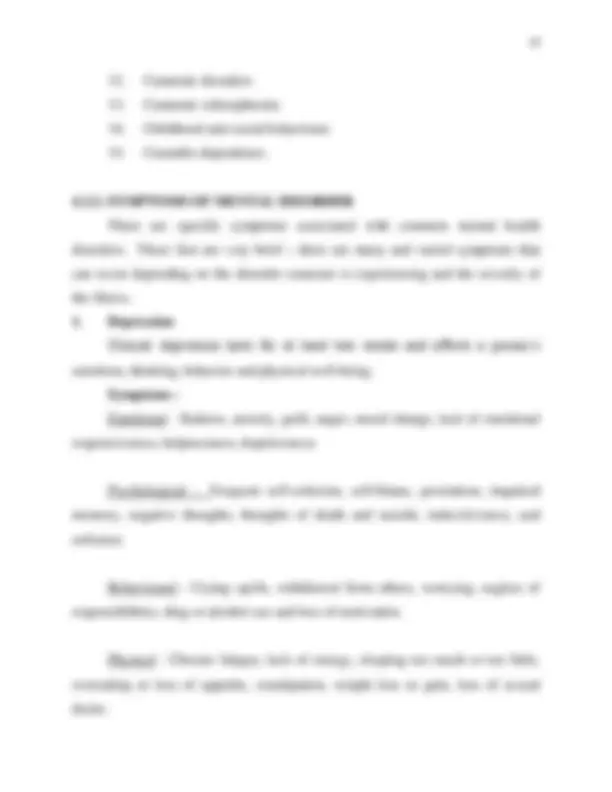
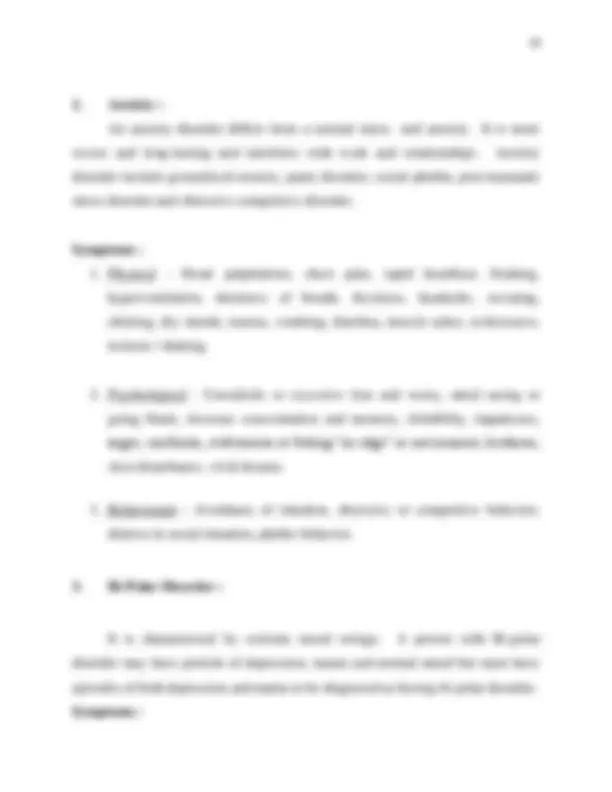
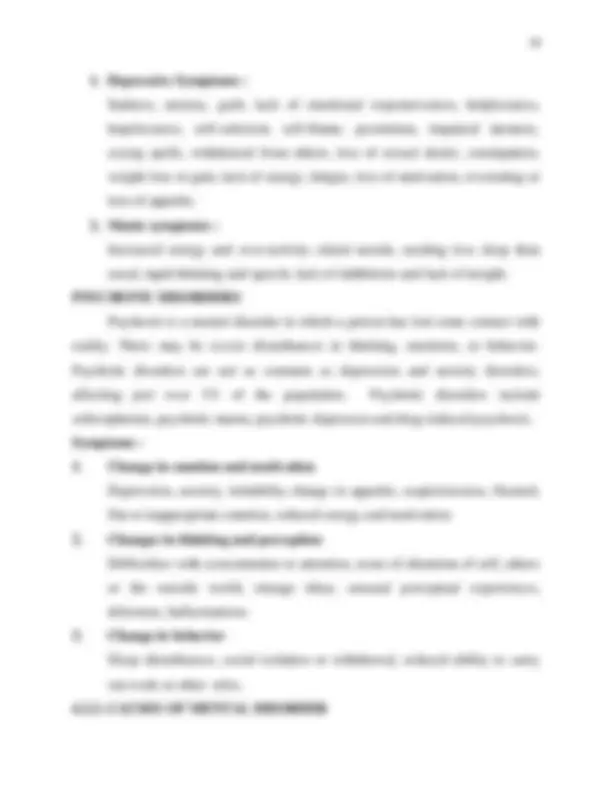


Study with the several resources on Docsity

Earn points by helping other students or get them with a premium plan


Prepare for your exams
Study with the several resources on Docsity

Earn points to download
Earn points by helping other students or get them with a premium plan
Community
Ask the community for help and clear up your study doubts
Discover the best universities in your country according to Docsity users
Free resources
Download our free guides on studying techniques, anxiety management strategies, and thesis advice from Docsity tutors
Theories of life span growth and development psychology
Typology: Thesis
1 / 194

This page cannot be seen from the preview
Don't miss anything!





























































































MSW Paper-III
Author Dr. Pratima Kumari Mishra
Syllabus
Unit-I Growth and Development.
Psychology: Relevance of Psychology for social work practice, Meaning of growth and Development, Approaches to study of Human Development, Principles of Human Development, Biological influences of Human Growth and Behaviours, Personality Theories, Psychodynamic and Behavioural Theories.
Unit-II Development Stages:
Physical, Social and Educational Aspects of the following developmental stages
with special reference to Indian conditions (a) infancy (b) Babyhood (c) Early
Childhood (d) Late childhood (e) Adolescence (f) Early Adulthood (h) Middle Age
(i) Old Age.
Unit-III Medical and psychiatric Information.
Concept of health and Hygiene. Communicable and deficiency diseases.
Unit-IV. Concept of normality and abnormality.
Symptoms, causes and treatment of the following Neurosis Psychopathic disorders and Mental retardation role of Social Worker in promoting health.
After learning this unit, the students will be able to:
Define Psychology Importance of Psychology for social work practice Differentiate between growth and development Learn about various approaches and principles of human development Understand the biological influences on human growth and behaviors Know about various personality theories of growth and development
Psychology owes its origin from Philosophy. In the year 1950, Rudolf Goeckle first used the word „Psychology‟. The term „Psychology‟ is a combination of two Greek words „Psyche‟ and „Logus‟ which mean „Soul‟ and „Science‟, respectively. It has a long history. A review of the history of psychology reveals that during the Greek period philosophers dominated the field of psychology. At that time, Psychology was not a separate discipline. It got scientific status in the year 1879, when Wilhelm Wundt established the first psychological laboratory at Leipzig in Germany. It has been defined differently by different philosophers and psychologists. The most appropriate definition of psychology has been advocated by R.S. Woodworth (1910-1960). According to him, “Psychology is the scientific study of the activities of the organism in relation to its environment”. Psychology is a positive science which helps to understand, predict and control human bbehaviour. It uses scientific methods to study different activities and experiences systematically. The word „activities‟ includes both external behaviours and internal mental processes. It studies behavior of living organisms, both animals and human beings. It acknowledges the role of environment in shaping the behavior of organisms. Thus, it is concluded that psychology is the scientific study of
behaviours, experiences and mental processes of the organisms in relation to the environment.
An individual lives in a society and different social processes influence the individual‟s attitudes, beliefs and values etc. As individuals interact with the environment and through interaction gain knowledge and experiences, therefore individuals‟ behaviours are moulded by the environment.
Psychology deals with activities of living organisms whereas social work practices concerned with the situations where those activities take place. Psychology can make things easier for social worker in order to understand the situation. It helps the social worker to understand the abilities, attitudes, personality, motivation of the individual and also facilities available in the environment of the person with whom the worker is dealing with. It provides any innovative solutions to reduce potential problems faced by the social work professionals. Social workers can save time and energy to find out the root causes of societal problems by interacting with the person who seeks help, his/her family members, friends etc. Social work concerns not only about the individual who uses the service of the social worker, but it also takes place in a social context. For example, the case of a physically disabled person and the situation where the person stays. The study of the human mind and behavior of the individual help the social worker to design an action plan to help the person. Psychology helps a social work professional service user in
Understanding different activities of the individual Knowing the cause of the particular activity Knowing the positive and negative qualities of the individual Understanding intelligence, abilities, attitudes, motivation, aptitudes and personality of the person Understanding actions and interactions of the individual in the peer group and causes of his activities Learning about the situation where an individual is
In Webster‟s dictionary development is defined as “the series of changes which an organism undergoes in passing from an embryonic stage to maturity.”
In Encyclopedia Britannica is the term development defined as “the progressive change in size, shape and function during the life of an organism by which its genetic potential are translated into functioning adult system.” So, development includes all those psychological changes that take in the functions and activities of different organs of an organism.
Development is continuous and gradual process (Skinner). According to Crow and Crow (1965) development is concerned with growth as well as those changes in behavior which results from environmental situation.”
Thus, development is a process of change in growth and capability over time due to function of both maturation and interaction with the environment.
Table 1.1A: Comparison of Growth and Development
Growth refers to physiological changes.
Development refers to overall changes in the individual. It involves changes in an orderly and coherent type towards the goal of maturity. Changes in the quantitative respect is termed as growth.
Development changes in the quality along with quantitative aspect. Growth does not continue throughout life.
Development continues throughout life. Growth stops after maturation.
Development is progressive.
Growth occurs due to the multiplication of cells.
Development occurs due to both maturation and interaction with the environment. Growth is cellular. Development is organizational. Growth is one of the part of the developmental process.
Development is a wider and comprehensive term.
Growth may be referred to describe the changes in particular aspects of the body and behavior of the organism.
Development describes the changes in the organism as a whole.
The changes produced by growth are subjects of measurements. They may be quantified and observable in nature.
Development brings qualitative changes which are difficult to measure directly. They are assessed through keen observation of behavior in different situations. Growth may or may not bring development.
Development is possible without growth.
Developmental psychologists believe that knowledge of an accurate pattern of development is fundamental to an understanding of children. There are several basic principles that characterizes the pattern and process of growth and development. These principles describe typical development as a predictable and orderly process. Even though there are individual differences in children‟s personalities, attitudes, behavior and timing of development, the principles and characteristics of development are universal patterns.
Changes in the brain and nervous system account largely for maturation. These changes in the brain and nervous system account largely for maturation. The child‟s environment and the learning that occurs as a result of the child‟s experiences largely determine whether the child will reach optimal development. An enriched environment and varied experiences help the child to develop his/her potential.
society and also what behaviors are expected from them. They realize from the approval or disapproval of their behavior. Social expectations are otherwise known as “developmental tasks”. Havinghurst defines developmental task as a “task which arises at or about a certain period in the life of an individual. Developmental tasks arise mainly (a) as a result of physical maturation, (b) form the cultural pressures of society, (c) out of the personal values and aspirations of the individual. The developmental tasks remain the same from one generation after another in a particular culture. As societies are evolving, changing traditions and cultural patterns of a society are learned automatically by children during their development process. These developmental tasks help in motivating children to learn as well as help parents to guide their children.
Fig. 1.1: Summary of Principles of Human Development
1.5. FACTORS AFFECTING HUMAN DEVELOPMENT
Human development is the process in which the changes occur in all the aspects of an organism from conception to death. It is a natural process for each and every child to grow. But it is observed that all children do not grow in the similar fashion. Some children‟s physical growth occur earlier than others, some
Individual differences in the development process
Development depends on maturation and learning
Development is predictable
Early development is more critical than later development
Development involves social expectation
Development has potential hazards
Happiness varies at different periods of development
are physically stronger than others, some are taller than others and so on. So far as mental development is concerned, some children have better cognitive ability, memory, reasoning, thinking ability etc. than others. All children also do not have same type of intelligence. Some have more musical talents, others have more intrapersonal intelligence, others also have more linguistic abilities etc. So, children differ from each other because several factors influence on their development. Some of the important factors have been enumerated below:
of the child and the next step is to provide adequate opportunities to develop the same. If proper identification of the ability is not possible and adequate facilities are not available to the child, then his innate ability may not be developed. Thus, adequate education and training have influence on human development.
Human development is a result of the interaction of biological, cognitive, socio-emotional and ecological processes. Genetic factors are the basic framework of the biological processes of development. For example, developments of brain, heart, lungs, nervous system etc. ; depend largely on the hereditary characteristics of the individual. Similarly, changes in the height, weight, sex characteristics are parts of the biological processes of development. Each and every individual tries to keep himself/herself both physically and mentally healthy. There are differences among individuals due to the biological basis of self-preservation. For example, a child who is physically stronger can overcome various problems that come across in the growing up than the less physically strong child. Similarly, the child who is emotionally stronger and stable can face various problems in life than the other child. Thus, physical as well as emotional strength relates to genetic factors. Due to the genetic factor some children have the desire to live longer while other children have the death wish is stronger. The biological influences are also observed in the needs of the children. For example, a child needs food when he is hungry, he requires water when he is thirsty and so on. These needs are associated with preservation of one‟s life. But how these needs are fulfilled depends upon socio-cultural influences. The biology of a person is interlinked with his behaviors. Thus, both body and mind are interdependent. Physical damage can result in mental problems and mental problems may affect physical well-being. As human being lives in a society, with his biological endowments he interacts with different stimuli of the environment. Social traditions, culture, beliefs, nationality and others influence human behavior. Both culture and behavior of the individual are inseparable. Thus, human
development and behaviors are combination of biological, social and psychological influences. For example, a child has talent in mathematics by birth due to hereditary factor but if the environment does support to develop his talent, the innate ability may not develop properly.
Characteristics of Biological Influences on Human Growth and Behaviors :- The human growth and behaviors can be understood from the characteristics mentioned below:
Personality theories have been classified into four groups. They are:
Trait Theories
Trait theories attempt to describe personality as the sum of certain traits. According to Kimble and Garmezy “trait is a stable and enduring attribute of a person which is revealed consistently in different situations.” Allport believed that the pattern of these traits is unique in each individual and determines his behaviours. Therefore, traits are consistent personality characteristics and behaviours manifestated in different situations. Trait theorists assumed that all people possess certain traits, but the degree to which a particular trait applies to a specific person varies and can be quantified. It is necessary for trait theorists is to identify specific primary traits in order to describe personality. For example, If we compare the personalities of two persons, one being extrovert and another being introvert. The extrovert person would be social, happy go lucky and would make friends easily while the introvert‟s behaviour would be shyness, lack of initiatives in social interactions etc.
Gordon Allport suggested that there are three major traits, viz. cardinal, central and secondary traits in personality. The special trait which provides uniqueness to the person is known as cardinal trait. The cardinal trait is observed in almost all the behaviours throughout one‟s life. A child who becomes the monitor of the class since beginning tries to be a leader in the state. Central trait refers to the major characteristics of an individual. These traits make up the core of personality. Central traits, such as honesty and sociability, they usually number from five to ten in any one person. Secondary traits are characteristics that affect behaviours of a person in fewer situations. These traits are less enduring. For example, a person is invited to attend a marriage party, He may wear sherwani for this purpose but in general he may like to wear casuals.
Personality psychologist Raymond Cattell (1965) viewed that personality is made of two types of traits – the surface traits and the source traits. He suggested that sixteen pairs of source traits represent the basic dimensions of personality. He called source traits as the core factors of personality and they are underlying internal traits responsible for behaviours. On the other hand, surface traits are some general traits and are possessed by all which are observable patterns of behaviour. He conducted research on these surface traits and applied factor analysis.
Another trait theorist Hans Eysenck (1992, 1994, 1995) also used factor analysis method to identify patterns of traits to discuss about the nature of personality. He viewed that personality could be described in terms of just three major dimensions: extroversion, neuroticism and psychoticism. The extraversion dimension relates to the degree of sociability, the neurotic dimension emphasizes emotional stability and psychoticism encompasses to the degree to which reality is distorted. Eysenck suggested that behaviour of a person can be predicted accurately in a variety of situations by evaluating along these three dimensions.
The most influential trait approach contends that five traits or factors – called the “Big-Five” – lie at the core of personality. Now-a-days the “Big-Five” represent the best description of personality traits. The “Big-Five” factors are : (a) Extroversion, (b) Agreeableness, (c) Conscientiousness, (d) Emotional stability and (e) openness to experience.
Extroversion refers to a personality dimension describing someone who is sociable, gregarious and assertive. Agreeableness describes someone who is good natured cooperative and trusting. Conscientiousness is a measure of reliability that describes someone who is responsible, dependable, persistent and organised. Emotional stability characterises someone as calm, self-confident, secure. The person with high negative scores can be nervous, anxious, depressed and insecure. Openness to experience dimension of personality characterizes someone in terms of imagination, sensitivity and curiosity.
Trait theories have also been criticized by some theorists. They have cautioned that personality traits will not be expressed in the same way across different situations. Walter Mischel has discussed about trait-situation interaction, in which the situation is assumed to influence the way in which a trait is expressed.